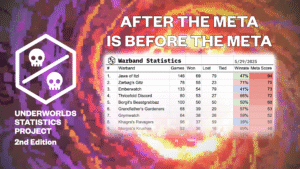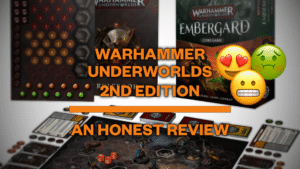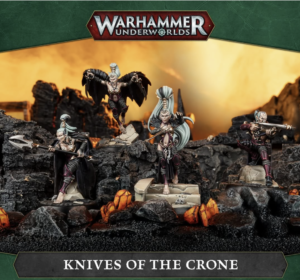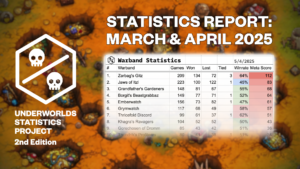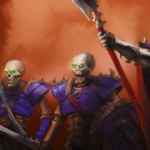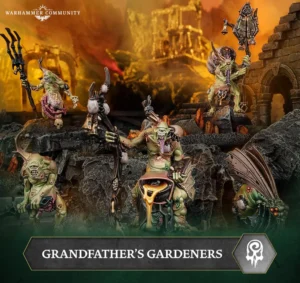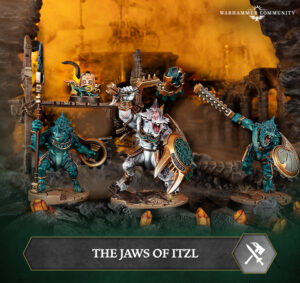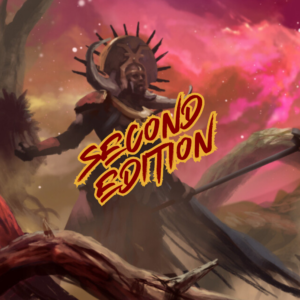Intro
Welcome back to another Path to Glory deck review! Now up: the Countdown to Cataclysm deck, first of the ‘Mastery’ decks in the new edition of Warhammer Underworlds! The Mastery style of deck, as defined by GW, involves introducing “new mechanics and goals, opening up entirely new ways to play.” In this particular case, we have a plot card centered around increasing our “Cataclysm Value”, dictated by a track to move along which, amusingly enough, counts ‘up’ rather than down. Missed opportunity, GW!
Plot Card
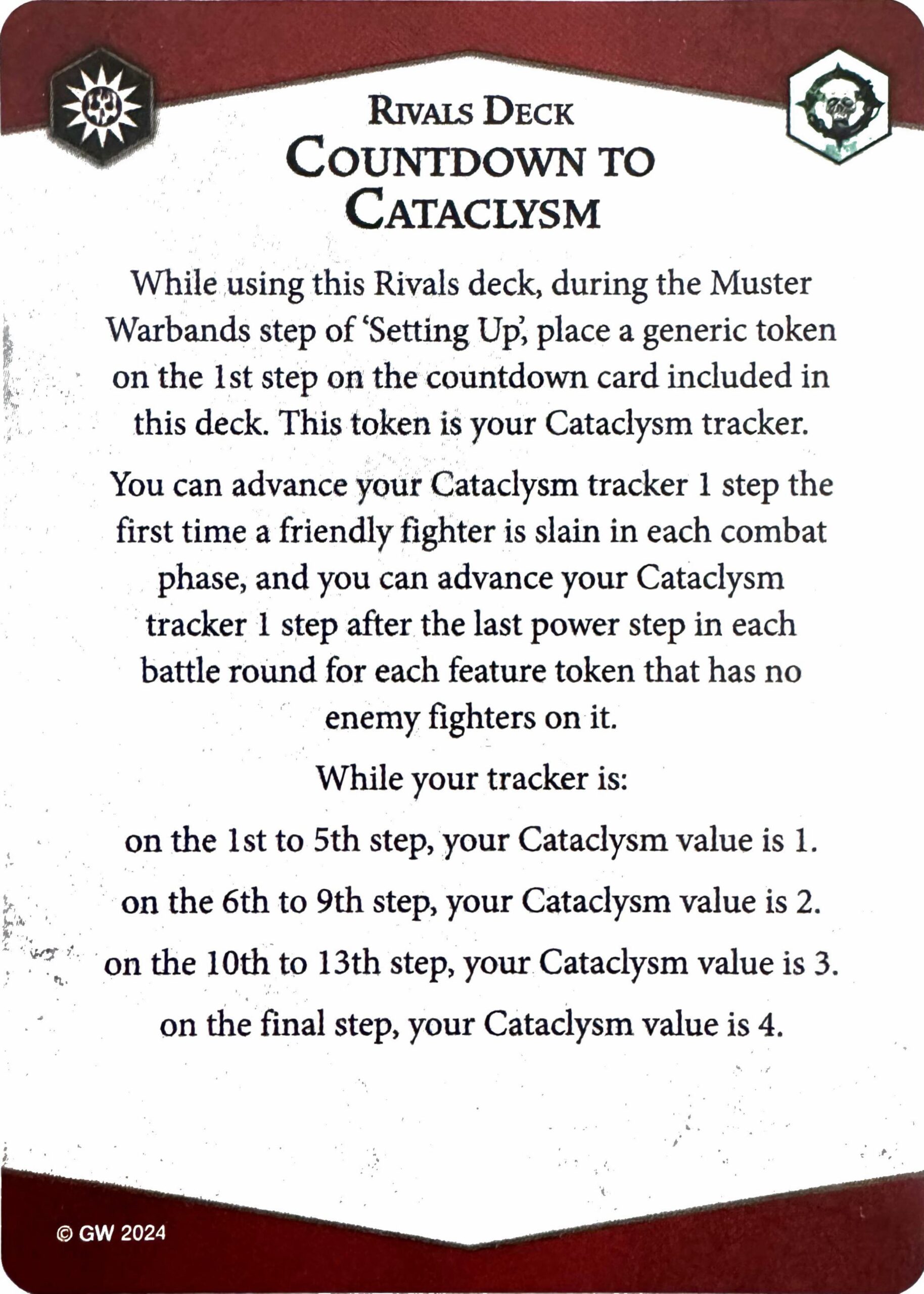
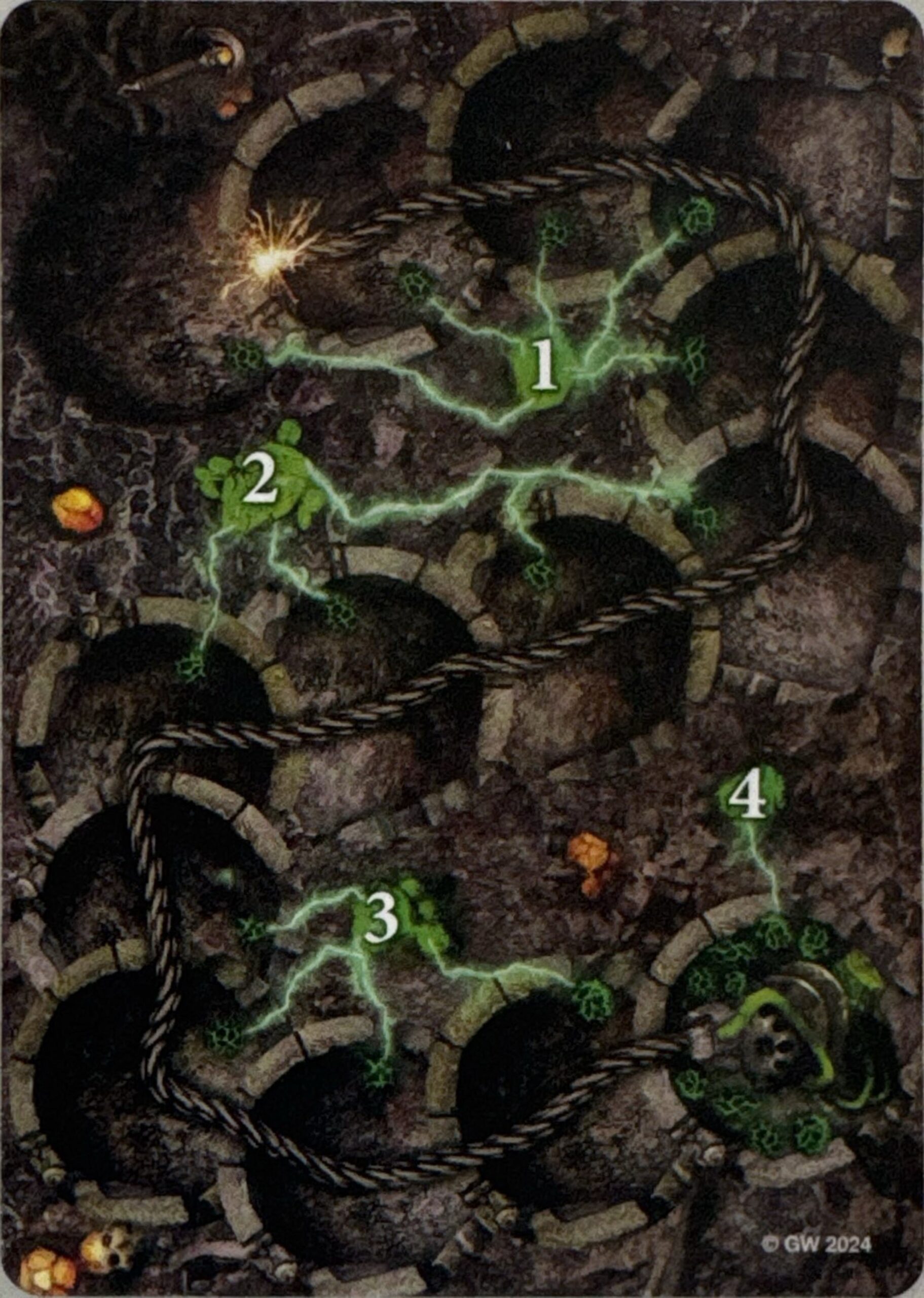
There are 14 steps to move along which correspond to Cataclysm values of 1 through 4, respectively. I will return later to discuss these steps further as without the context of the cards which interact with this it is very hard to evaluate in a vacuum. The important note here is that, independent of the cards, the cataclysm tracker advances 1 step the first time a friendly fighter is slain in each combat phase, and after the last power step of a combat phase you advance the tracker 1 step for each feature token that does not have an enemy fighter on it.
With the caveat that this is absent any other card considerations, we can see that it is very reasonable to expect to reach the 12th or 13th step of the cataclysm tracker by the end of each game, corresponding to a Cataclysm value of 3, if we assume that we will lose 1 fighter in each round and that we can permit our opponent to stand on no more than 1 or 2 tokens in each round.
Now, on to the deck itself! I will be rating each card from 1 to 3 along three separate measures: power, consistency, and universality. In simple terms, Power refers to the peak output of the card – how impactful it is when played at the right time. Consistency refers to how often the time is right to play the card, or how often you can play it for its full power. Universality measures how broadly applicable the card is, whether it works with a variety of warbands or playstyles or if it is likely to work only with more niche strategies. In the new edition this is the metric which may be hardest to gauge, of course.
Objectives
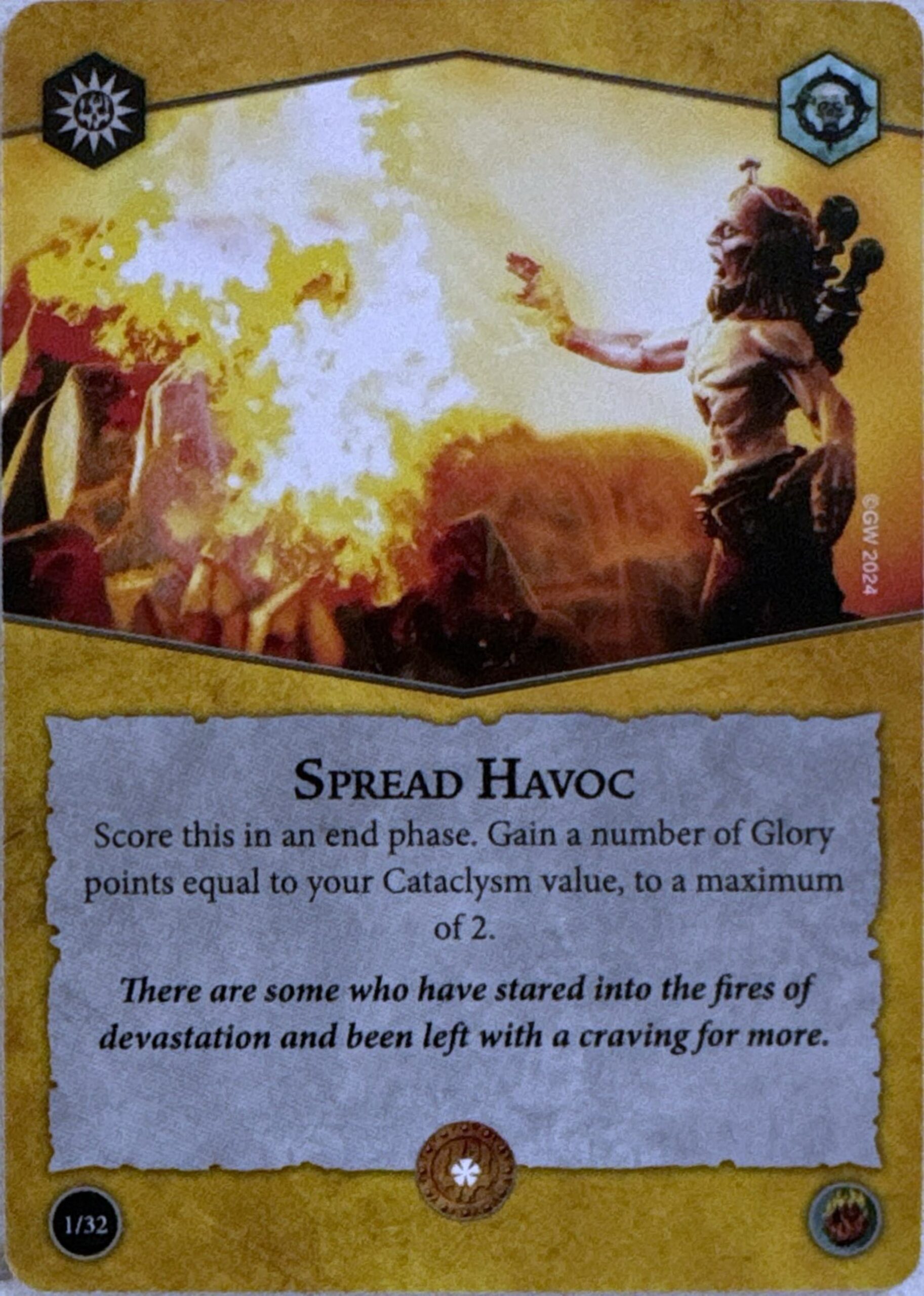
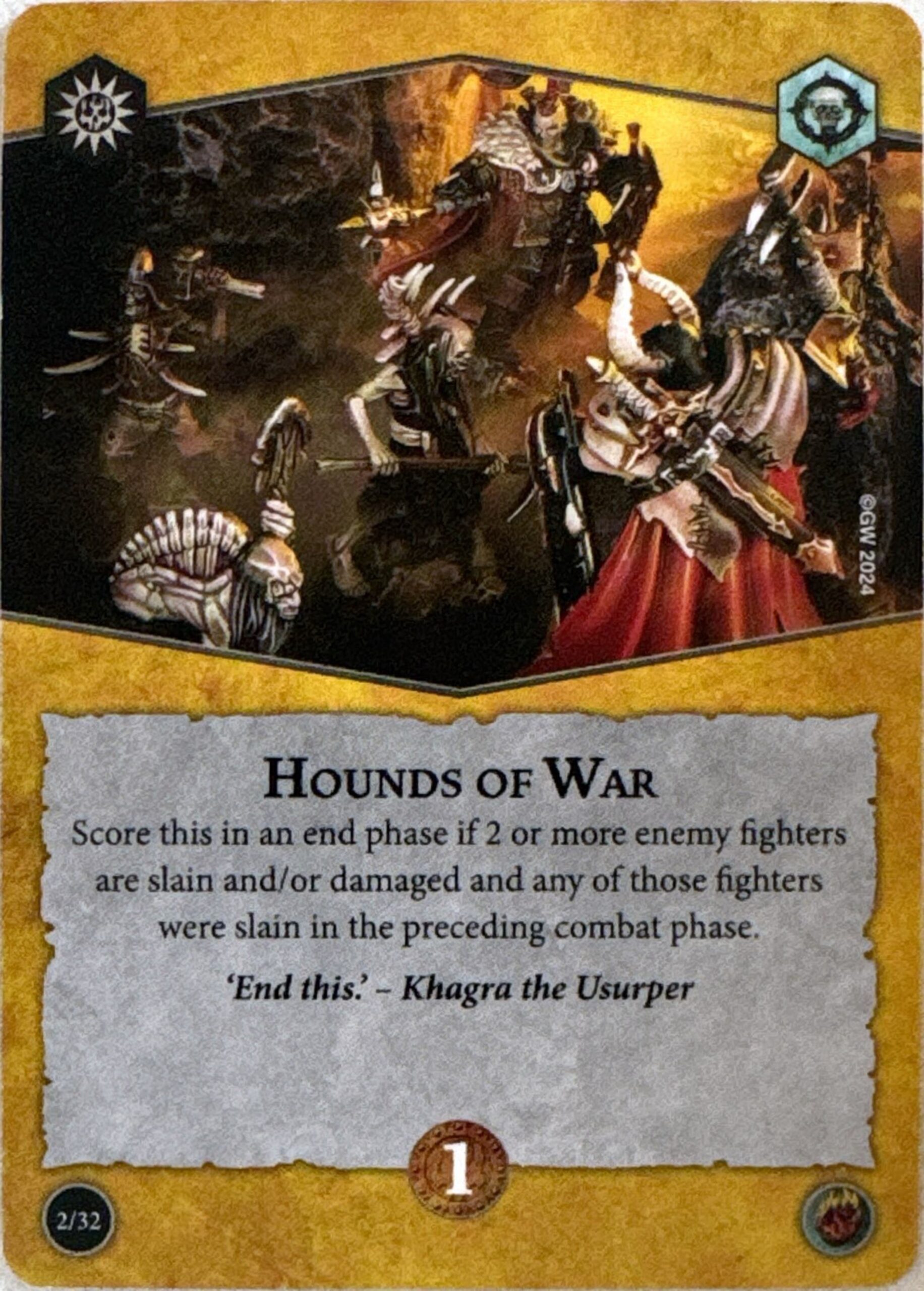
Spread Havoc
This objective is a good start for making the cataclysm count relative in each game, and indeed, is literally impossible to not score – something of a first for the game. While you have to do a bit of work to score it for 2 glory, from the beginning of the game your cataclysm value is 1 so you can always score this for at least 1 glory. While some warbands may struggle a little more than others to ramp up their cataclysm value, an end phase I can always score for 1 glory in any game state is simply too good to ever skip.
Power: 3
Consistency: 3
Universality: 3
Hounds of War
The conditions here aren’t a ton of work, but they do require at least 1 kill in the preceding combat phase, which I’m sure in certain matchups or at certain times could be challenging. The payoff here is a rather meagre 1 glory, but for “kill 1 enemy and damage 1 enemy” its not a huge ask. Overall while this isn’t a particularly exciting or interesting objective it is a board state which should more or less be true very frequently, with the only note that against elite warbands it may be a struggle in the first round.
Power: 1
Consistency: 2
Universality: 2
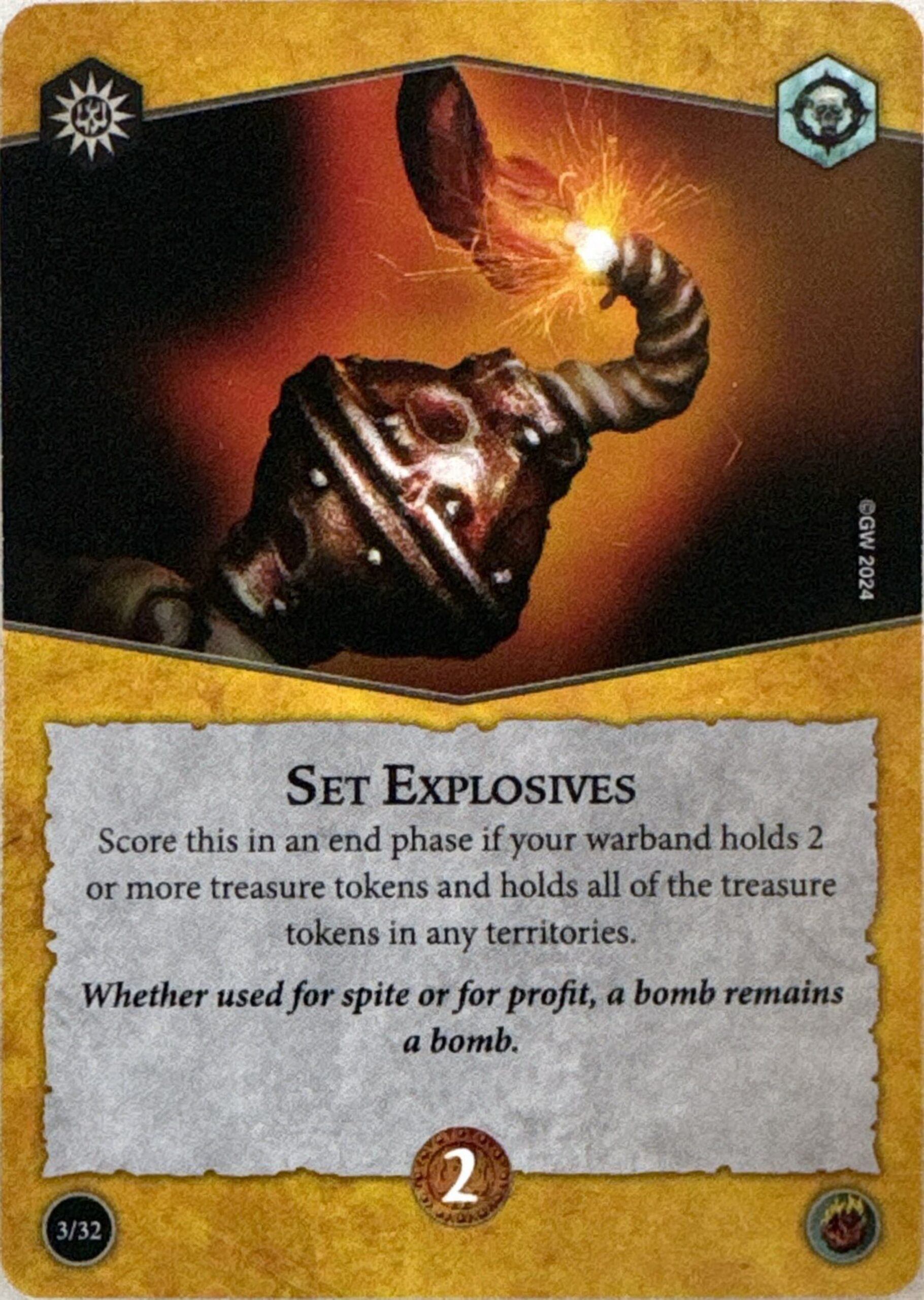
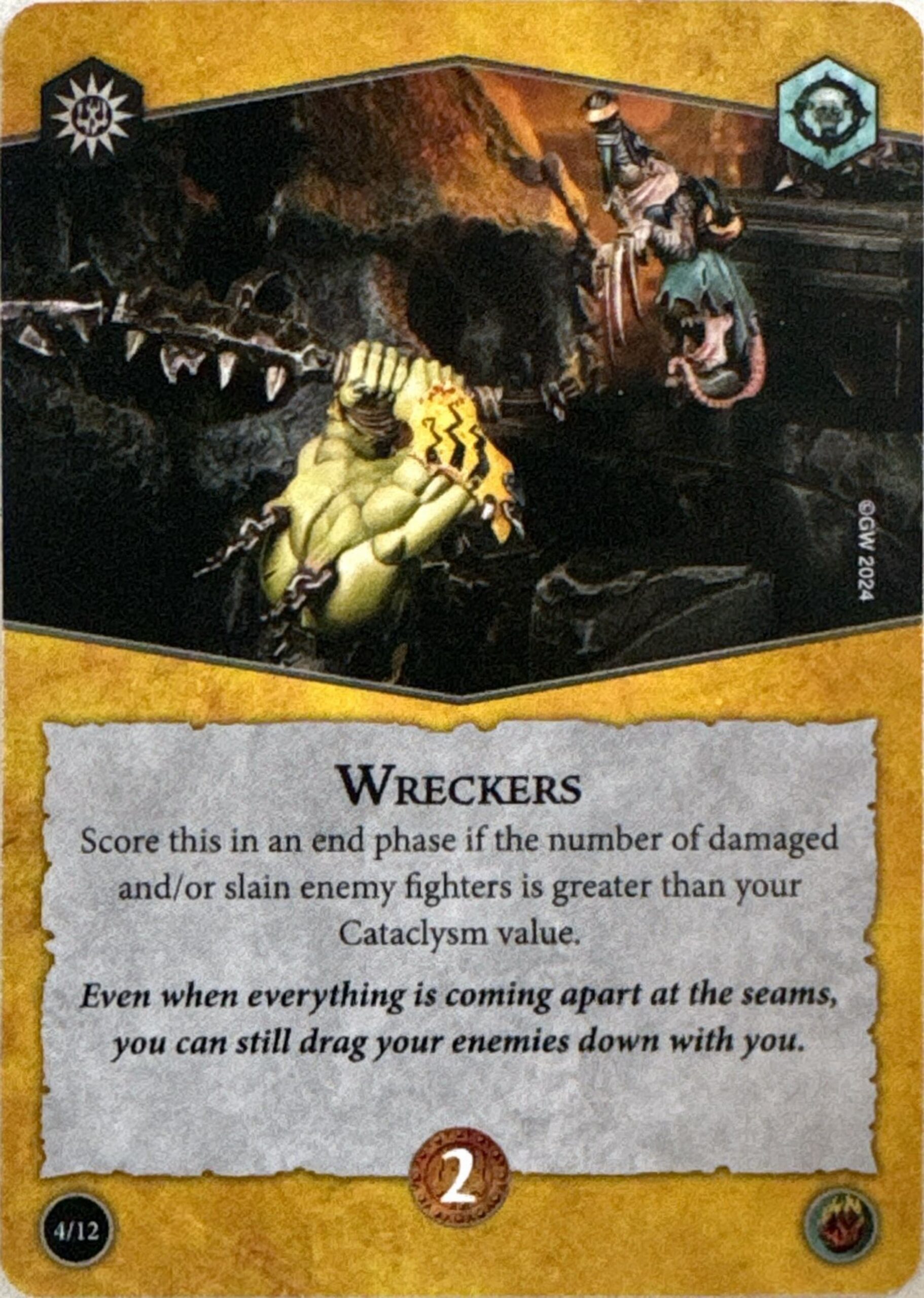
Set Explosives
A more interesting objective, holding 2 treasure tokens and all treasure tokens in any 1 territory is a reasonable condition, especially given the relative likelihood of there being only 1 treasure token in no one’s territory. For a 2 glory payoff this is strong but fair.
Power: 2
Consistency: 2
Universality: 2
Wreckers
Continuing the trend of interesting objectives we have a rather ironic mind-game here. This objective gets harder to score as you increase your cataclysm value and thus your payoffs on other cards, interestingly offering your opponent some strange counterplay in the form of deliberately letting you ramp up your cataclysm value. While I think this sort of bait card is interesting and potentially good, it does ultimately ask a lot of you. Killing or damaging 2-3+ enemy fighters in the first round is a high ask and by the end of the game it may even become unscoreable against elite enemies if your cataclysm value creeps up to 3 or 4.
Power: 2
Consistency: 1
Universality: 1
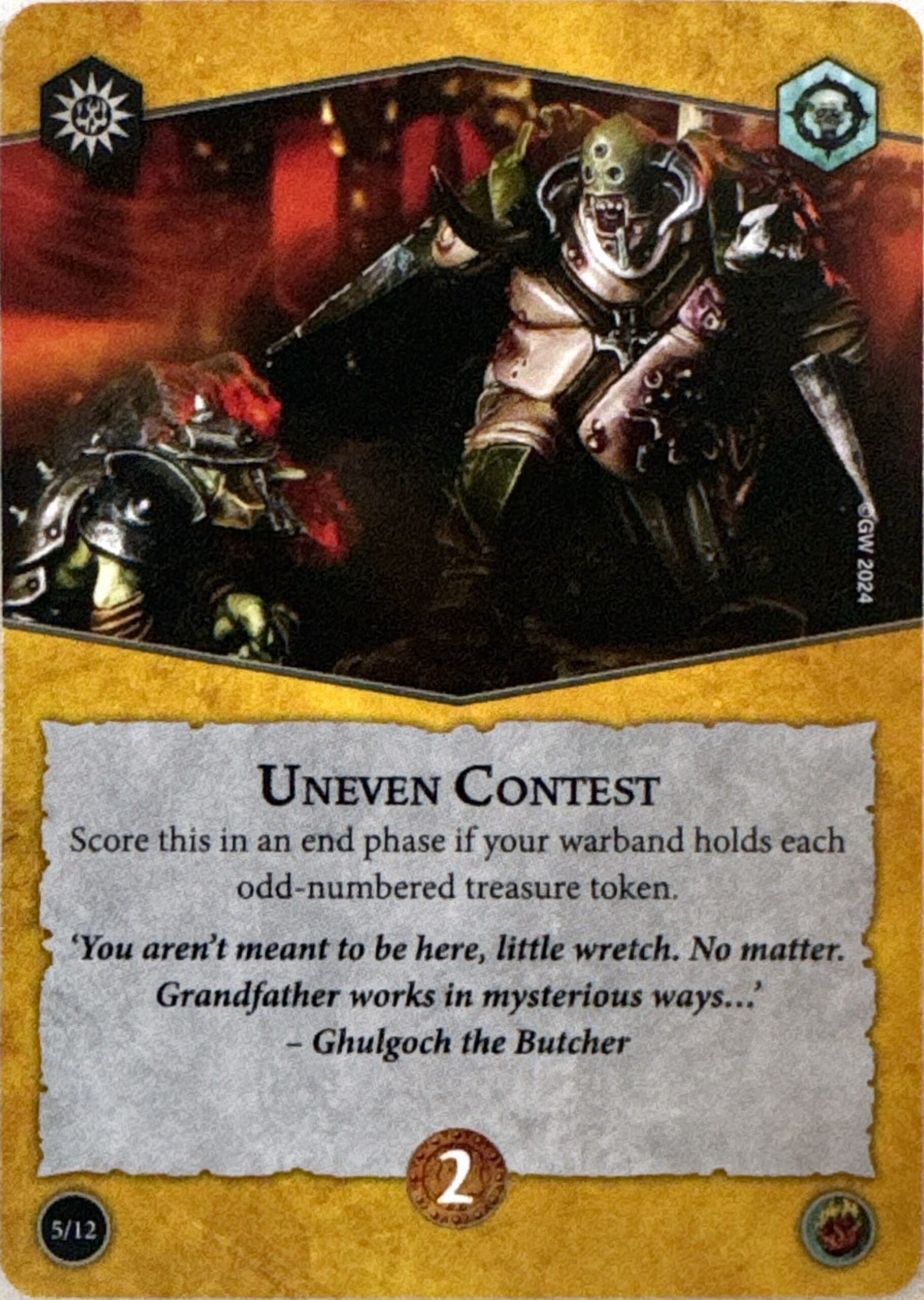
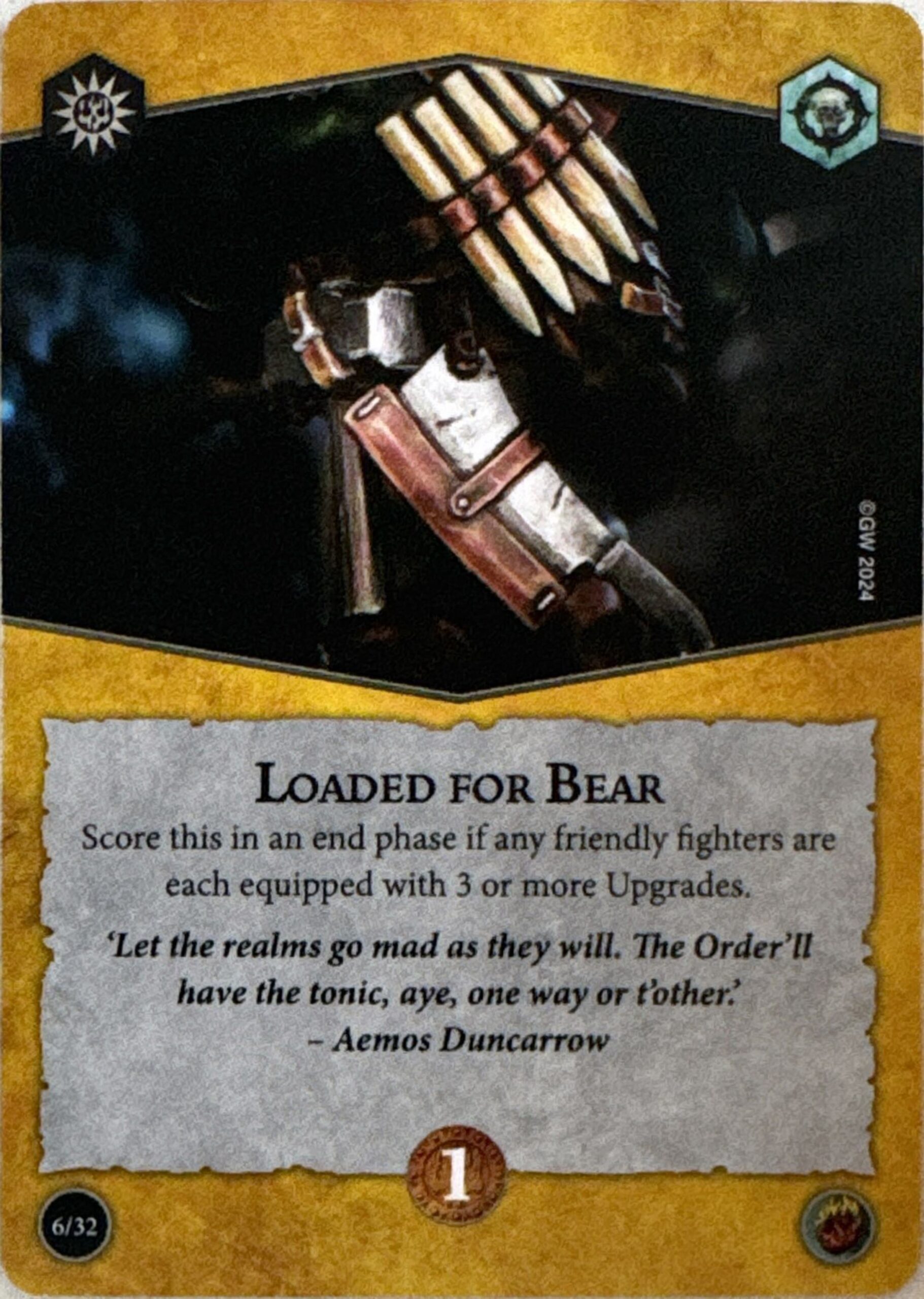
Uneven Contest
This sort of objective is a bit strange and difficult; while you may potentially be able to delve some of the odd tokens this is still a bit situational, difficult to achieve, and ultimately a lot of work for the payoff it provides unless you have the happy accident of your opponent assisting you by delving an odd objective and not delving it back.
Power: 2
Consistency: 1
Universality: 1
Loaded for Bear
We’ve seen this exact objective numerous times in the past and while it isn’t particularly exciting, it has been a workhorse for control and elite warbands.
Power: 2
Consistency: 2
Universality: 2
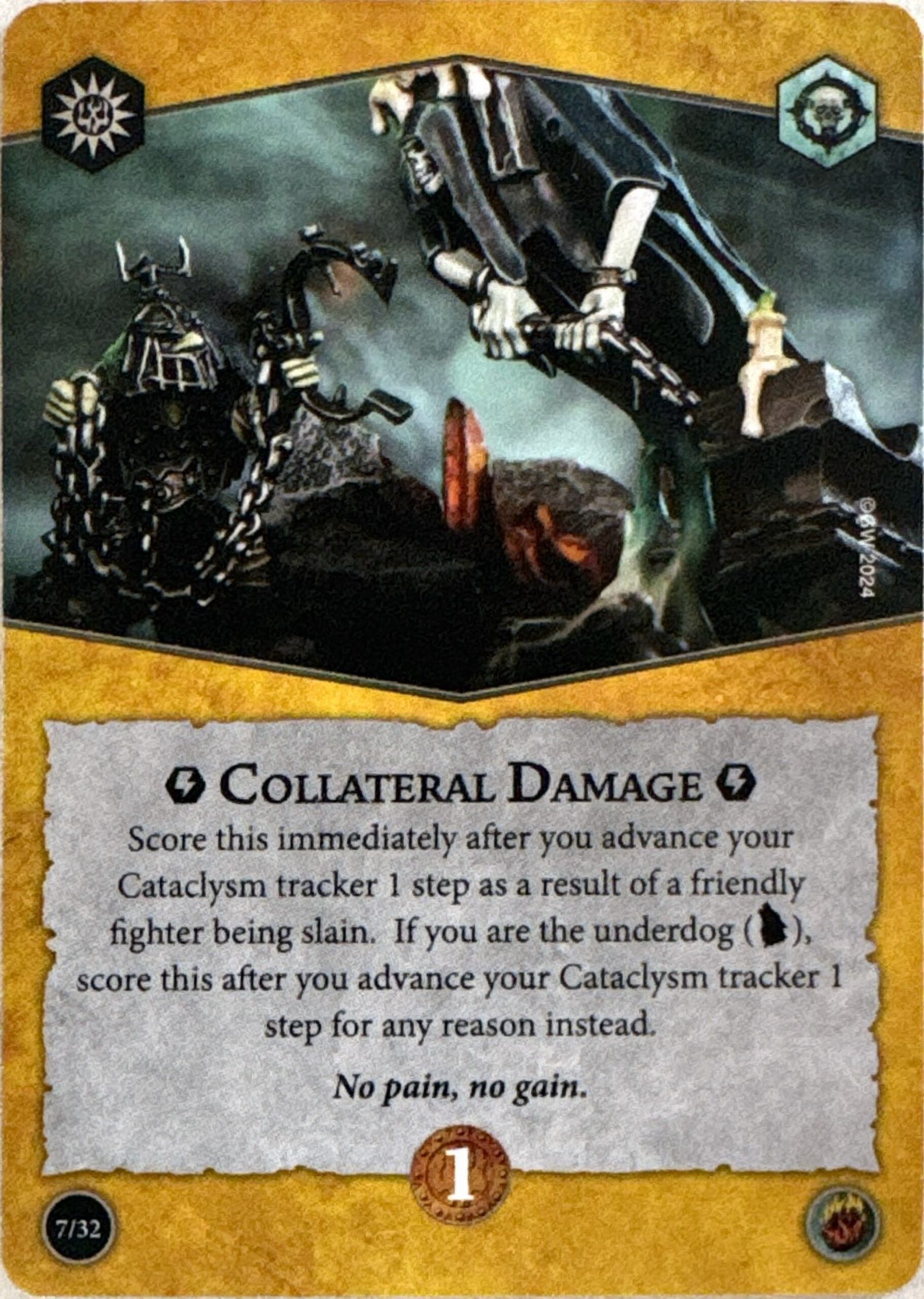
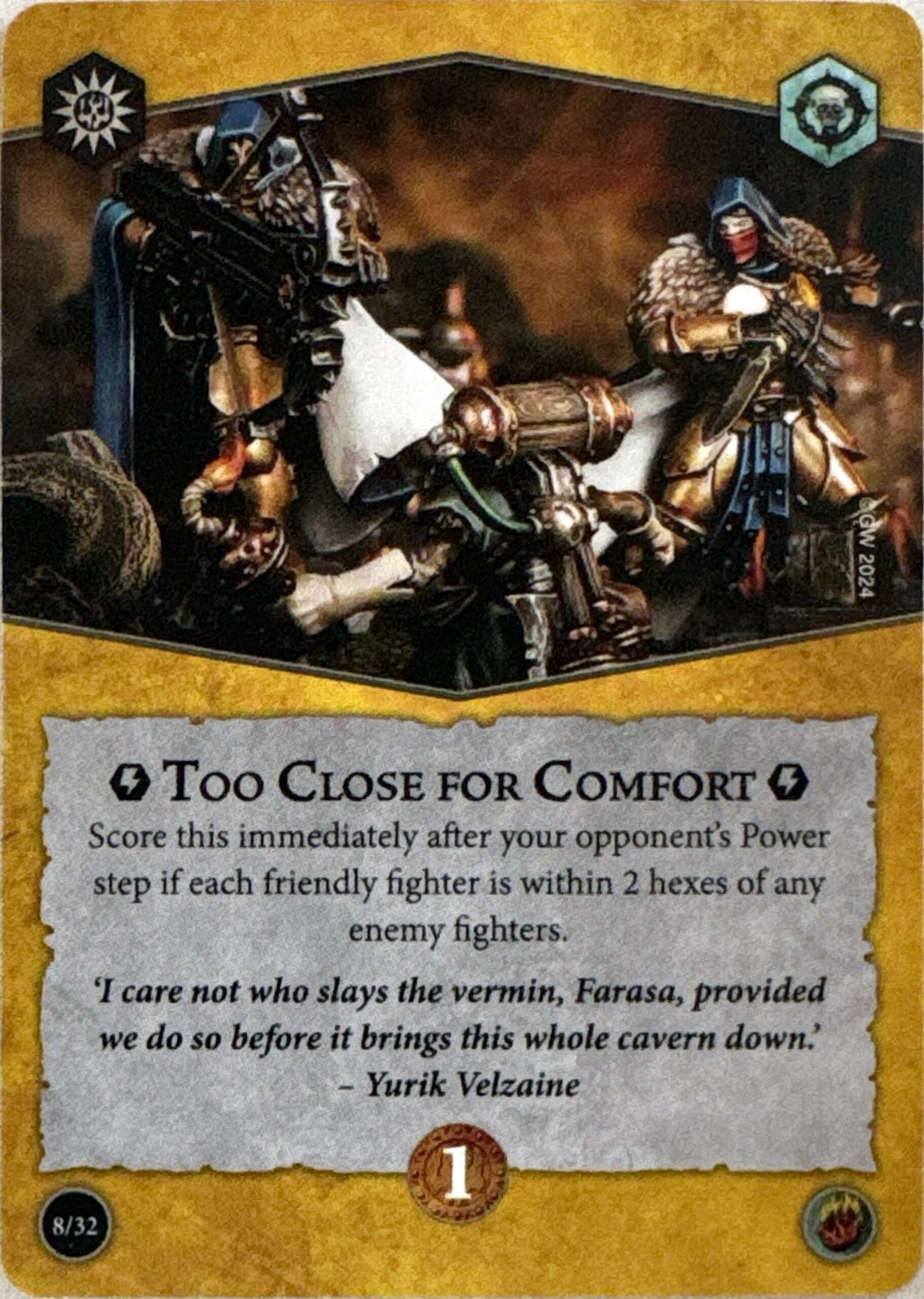
Collateral Damage
Our first surge objective of the deck, with underdog mechanics on it to boot. This is an extremely consistent surge with the limitation that you can’t score it the non-underdog way if you draw it after the first friendly fighter in a combat phase is slain, but once you are the underdog you can score it via numerous cards in the deck as well as after the last power step if your opponent is on less than all 5 feature tokens (i.e., every time). The only time you don’t score this is if you have the bad luck to draw into it during a round (i.e., you are scoring other cards) and you are still winning at the end of that round.
Power: 3
Consistency: 3
Universality: 3
Too Close for Comfort
A fairly simple but very aggressive surge with interesting implications, this one can be a bit tricky as it is predicated on fighters charging in to close range but not killing the target of their charges. Obviously the simple way to do this is by charging yourself and it gets easier if your opponent charges back at you, I think that while this could be tricky to deny it will be possible, especially given the awkward timing for scoring it allowing your opponent time to leverage driveback and their own pushes. It is also a bit anti-synergistic with any game plan involving spreading out or holding tokens with fighters at a distance from enemies.
Power: 2
Consistency: 2
Universality: 1
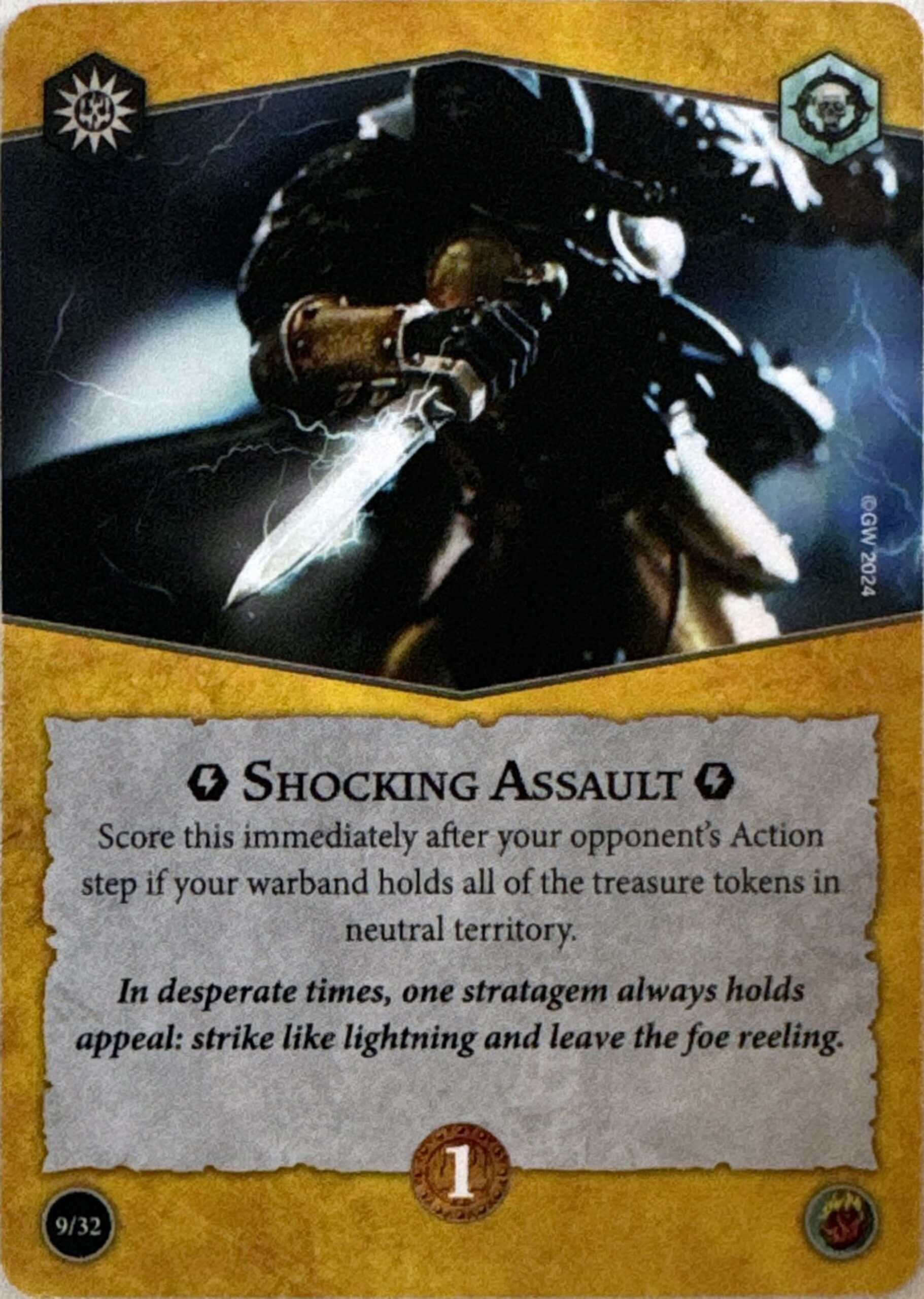

Shocking Assault
A surge for holding tokens in no one’s territory, the timing window on it leaves it difficult and the requirement for “all” the tokens may prove problematic. Still, if your deck or warband offer tools to be on guard or become un-pushable it could also be very simple.
Power: 2
Consistency: 2
Universality: 2
Nowhere to Run
The first part of this surge says play me with an elite warband and be aggressive, but the second condition says be a horde with movement economy and/or raised fighters. Taken together, this surge is only for specific warbands, but will be quite trivial for those warbands to achieve.
Power: 2
Consistency: 2
Universality: 1
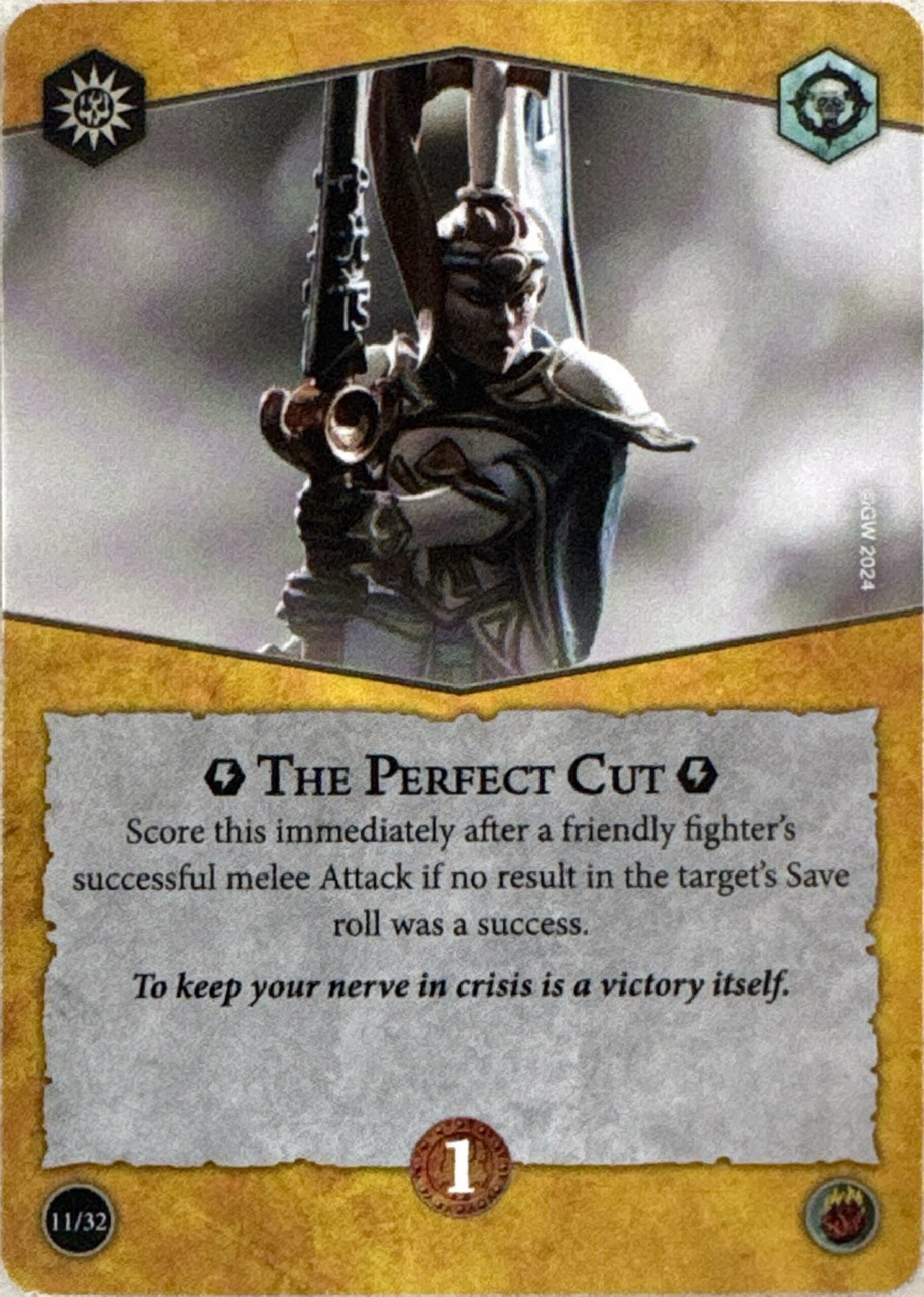

The Perfect Cut
I’m normally not a fan of dice-based surges like this, especially one where the dice in question are my opponent’s. This one may get harder against warbands and decks that can reach 2-3 or more defense dice and is easy enough against enemies who roll only 1 defense die. You can game the value here a little by including cards or having cleave/ensnare/brutal somewhere on your warscroll, and it will happen at some point in every game unless your luck is abysmal or theirs is exceptional. A further limitation is that it requires the attack be both successful and a melee attack. Ultimately, this kind of surge is a bit win-more, as if my attacks are hitting I’m likely already being rewarded, and the extra hoop to jump through of your opponent’s dice whiffing is potentially frustrating.
Power: 1
Consistency: 1
Universality: 2
Overwhelming Force
Another dice-based surge that requires a successful melee attack, at least this one has a condition I can control or influence, that being the dice characteristic of the attack. While your enjoyment of this will scale heavily with your warband’s base accuracy and whatever +dice cards you can slot in, for those warbands it’s likely to be quite fine, especially because at 4 dice we start feeling much more comfortable about expecting an attack to hit.
Power: 1
Consistency: 2
Universality: 1
Ploys
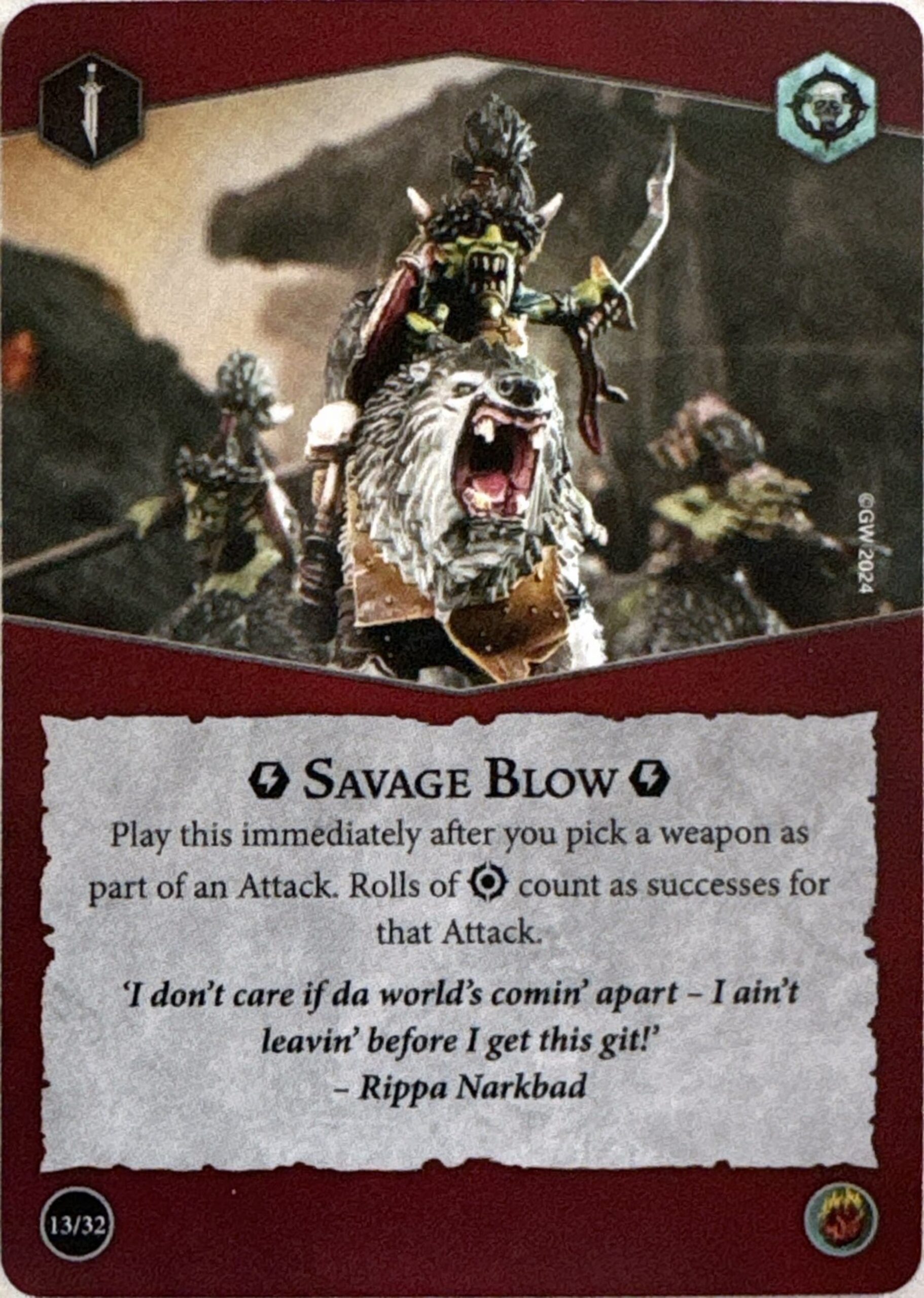
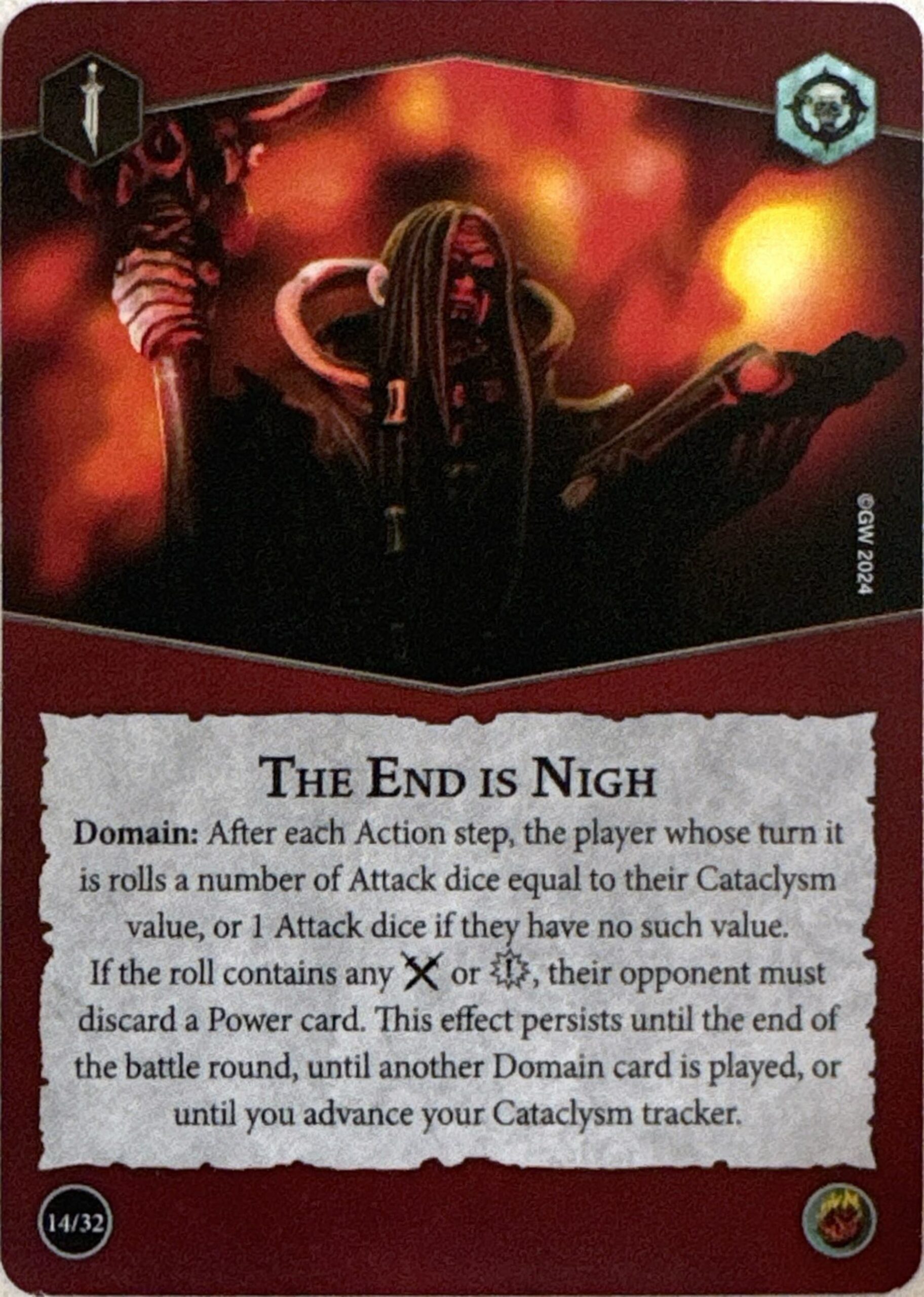
Savage Blow
I’ve never been especially fond of this effect and that remains true. While it is an accuracy boost, it is not especially substantial unless I am already rolling a lot of dice (in which case I didn’t need the boost!). It also has no synergy with the dice-based surges in this deck, as it does not modify the enemy save roll nor does it increase the number of dice in my attack roll.
Power: 1
Consistency: 3
Universality: 3
The End is Nigh
A double-edged effect, at least it will generally be weaker against you than it is against your opponent, but the random element and the chance of punishing myself with it is unappealing. Additionally, this stops persisting as soon as you advance your cataclysm tracker, so simply by doing what they probably already wanted to do (slaying one of your fighters) your opponent mitigates the value of this card, limiting the timing on when you’ll want to be playing it.
Power: 2
Consistency: 1
Universality: 1
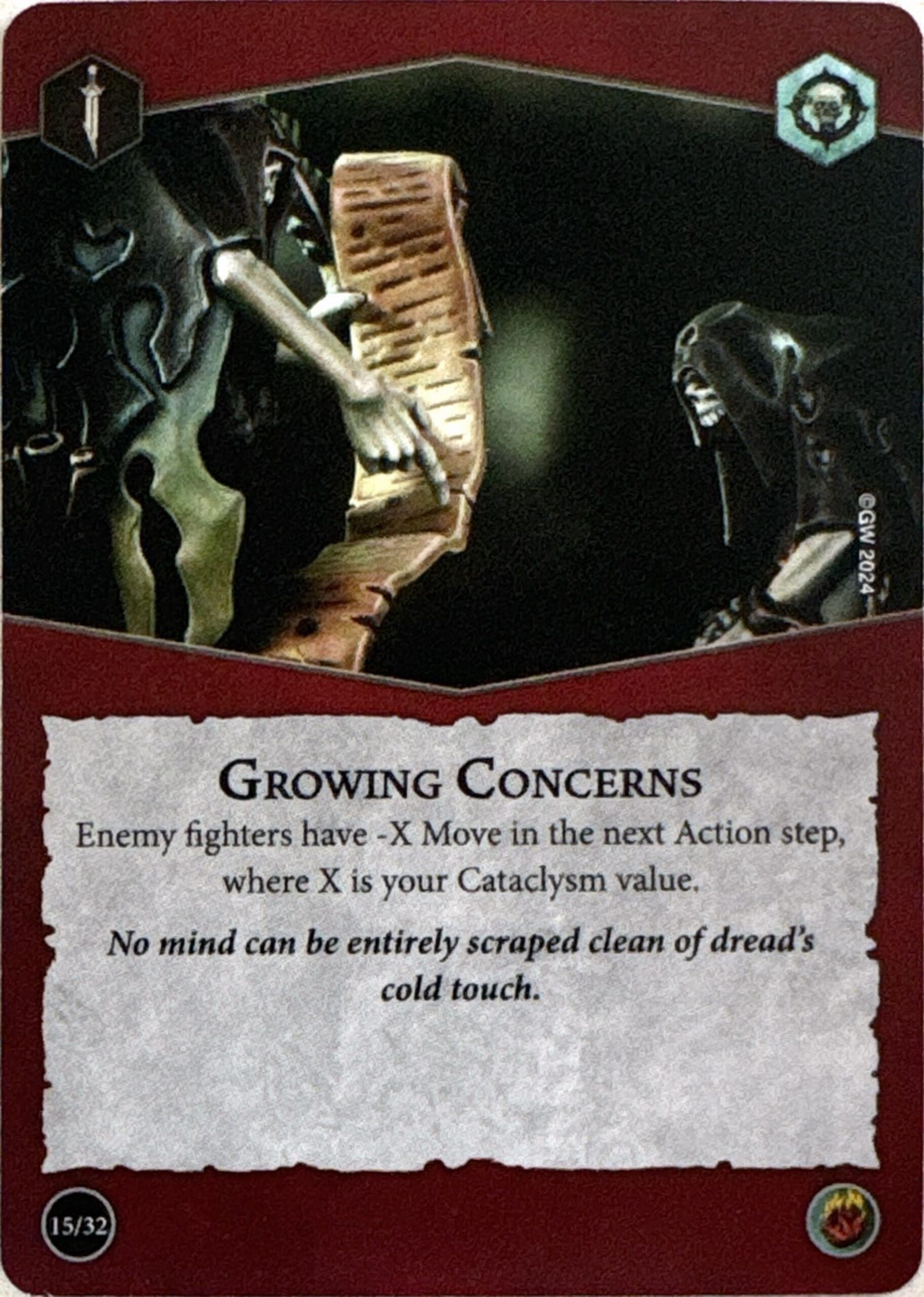

Growing Concerns
This sort of effect can be useful for denying charges or tokens to enemies, but to really be significant at denying any useful options to your opponent for that turn you need a cataclysm value of 3 or 4, meaning this card is fairly lackluster early and your window to use it may close once it gets late in the game and all fighters are quite close together. Still, we’ve seen mostly low move characteristics so far, so this can be fairly impactful.
Power: 2
Consistency: 2
Universality: 3
Total Collapse
I’ve said it before, I don’t like cards that can fully whiff. If this card was slightly more likely to go off (working on hammers and crits rather than swords and crits, for example) I would be more positive on it. While it will be *reasonable* in the late game it will by no means be reliable most of the time. At 4 cataclysm value, this card works 80.24% of the time, at 3 cataclysm value 70.3%, at 2 cataclysm value 55.55% and at 1 cataclysm value only 33.33%. Typically we prefer cards like this to work upwards of 75%, meaning the vast majority of the time this card is under par. Still, it’s a ping that doesn’t care about positioning and has the edge case of being able to hit your own fighter for your cataclysm value instead of just 1 damage, which I don’t expect to do often, but it is something.
Power: 3
Consistency: 1
Universality: 3
Violent Blast
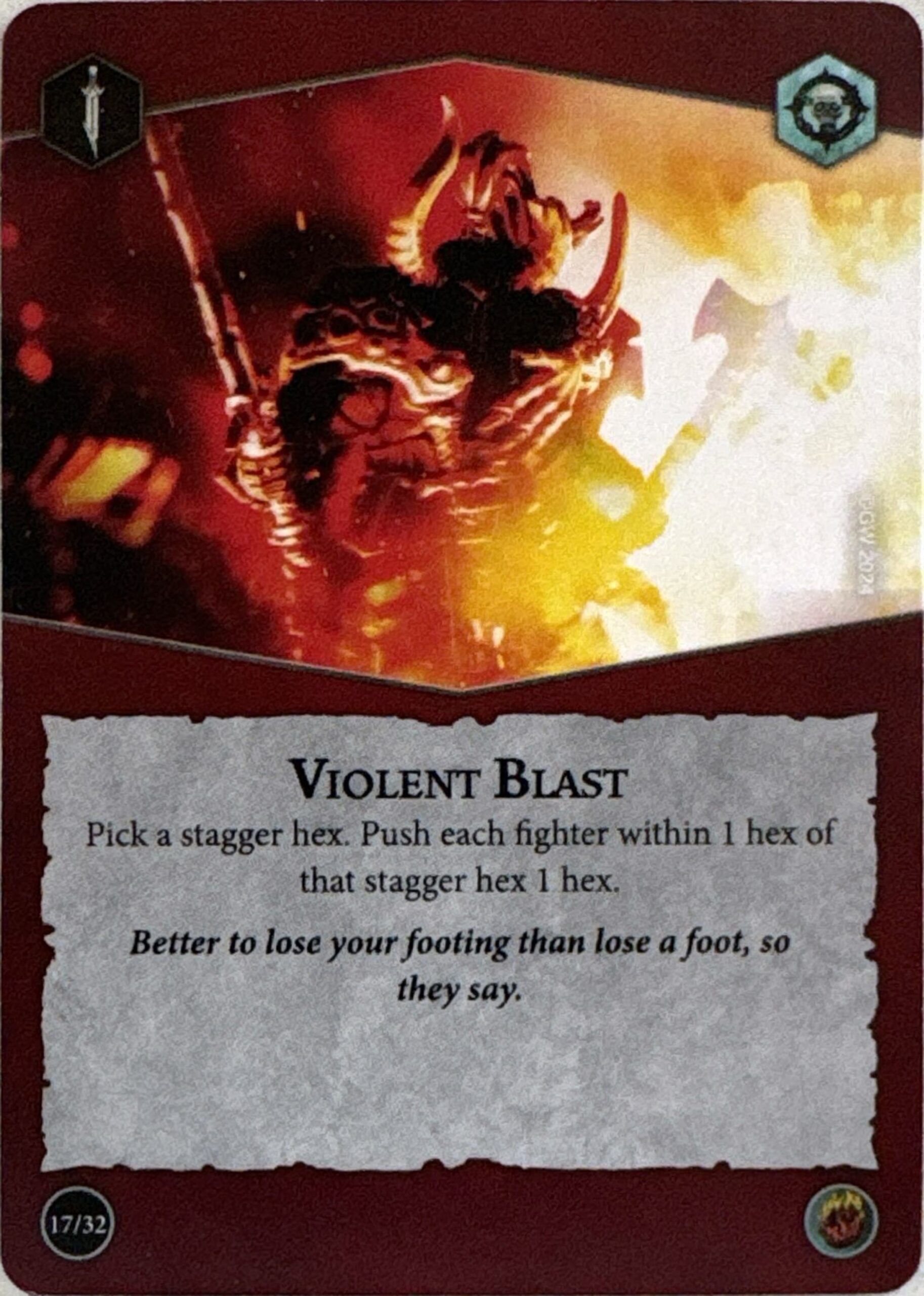
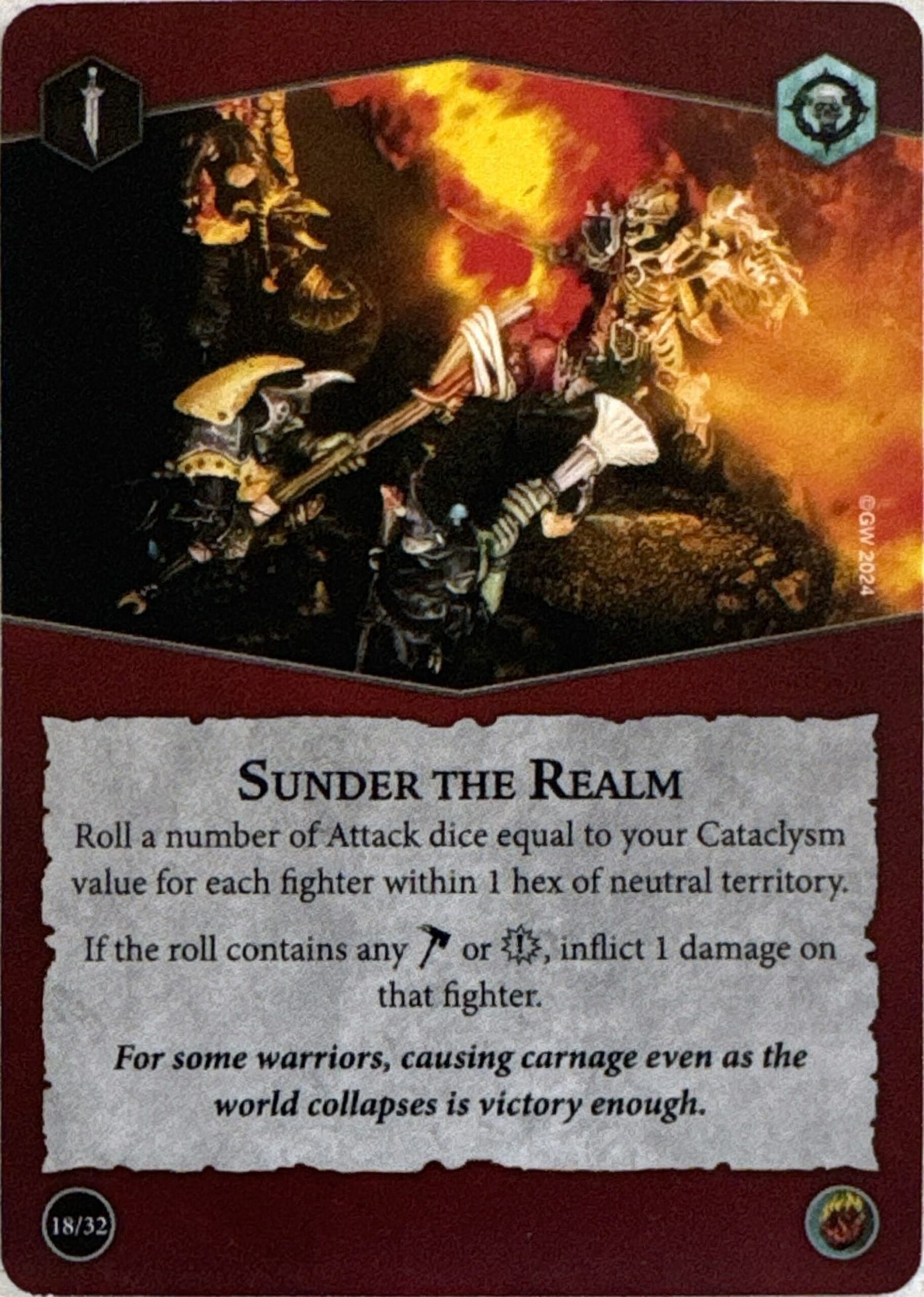
This is a strong card, limited only by the current boards. Depending on the options for the number and placement of stagger hexes, of course, but as it lets you push each of the fighters within 1 of a given stagger hex you can frequently have a high number of options, and this is a relevant push especially for every feature token that ends up placed within 2 of a stagger hex.
Power: 3
Consistency: 3
Universality: 3
Sunder the Realm
I will fight past my tears to objectively evaluate this card without comparison to its namesake. The odds of any given fighter within 1 of neutral territory getting a ping are higher than for Total Collapse, but aligning the positioning of fighters to the right area with your Cataclysm Value for best odds of a payoff is going to be quite tricky. Additionally, there is a high possibility here for friendly fire. Still, the potentially payoff is quite high.
Power: 3
Consistency: 1
Universality: 2

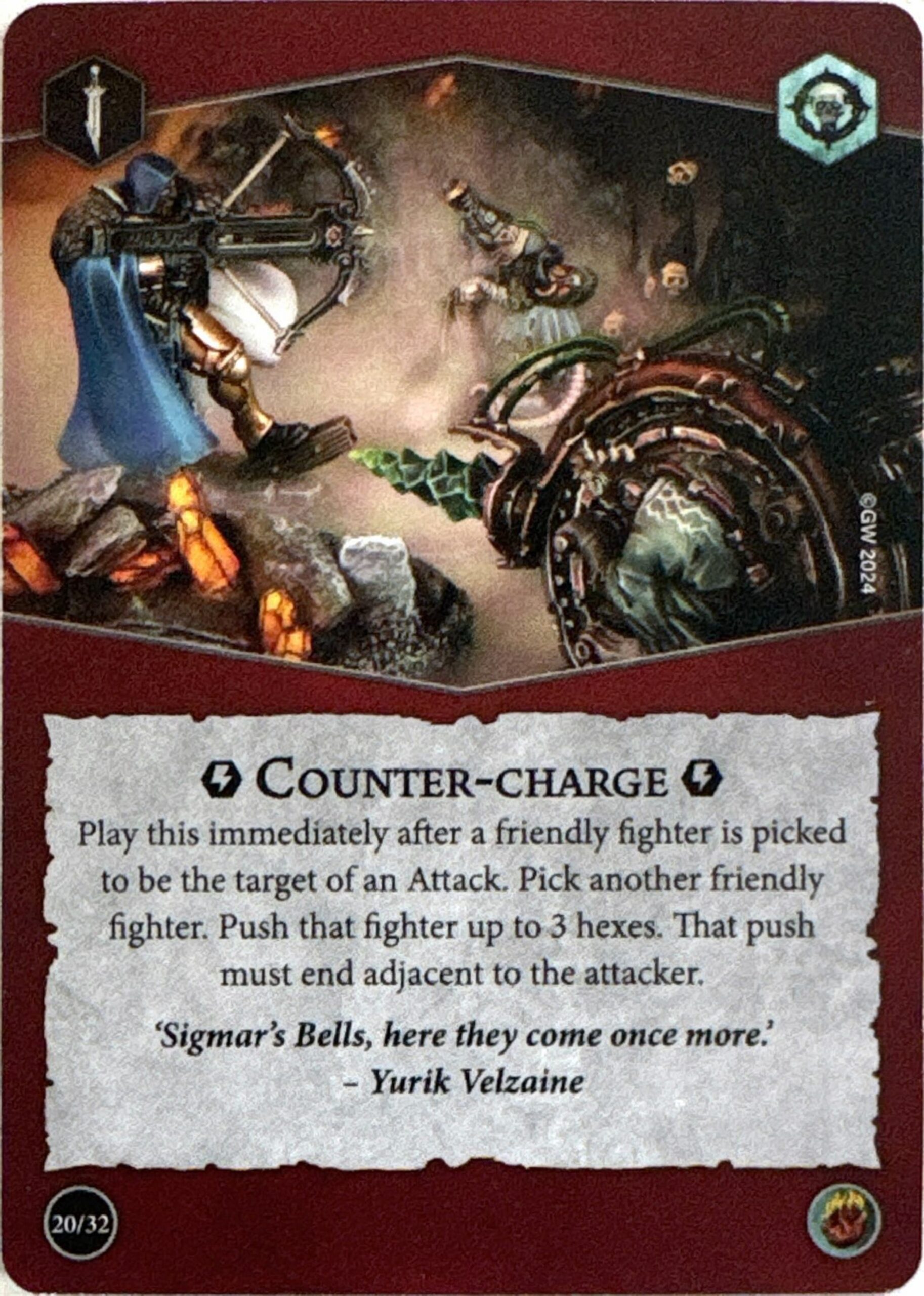
Raging Tremors
At last, a Cataclysm Value payoff that scales total throughput rather than consistency. While the payoff can be moderately low (“just” a stagger token) staggering any 1-2 enemies early in the game could be very useful to help force your attacks through. If you’d play a gambit to get a reroll for 1 attack once (which, while a low bar, is at the edge of playable) stagger any 1 enemy fighter is an acceptably low bar for the start of the game for this card, and it only goes up from there.
Power: 2
Consistency: 3
Universality: 3
Counter Charge
A slightly weakened or at least side-graded version of a classic favorite (you must now choose another fighter instead of being able to also push the target of the attack), its still very, very useful. Between letting you force a defensive support, take an important position that the enemy might’ve wanted to push to after the attack, impose some sort of effect based on proximity to the fighter you pushed, or even set up a better charge or attack for your turn, there are a great many possibilities.
Power: 3
Consistency: 3
Universality: 3
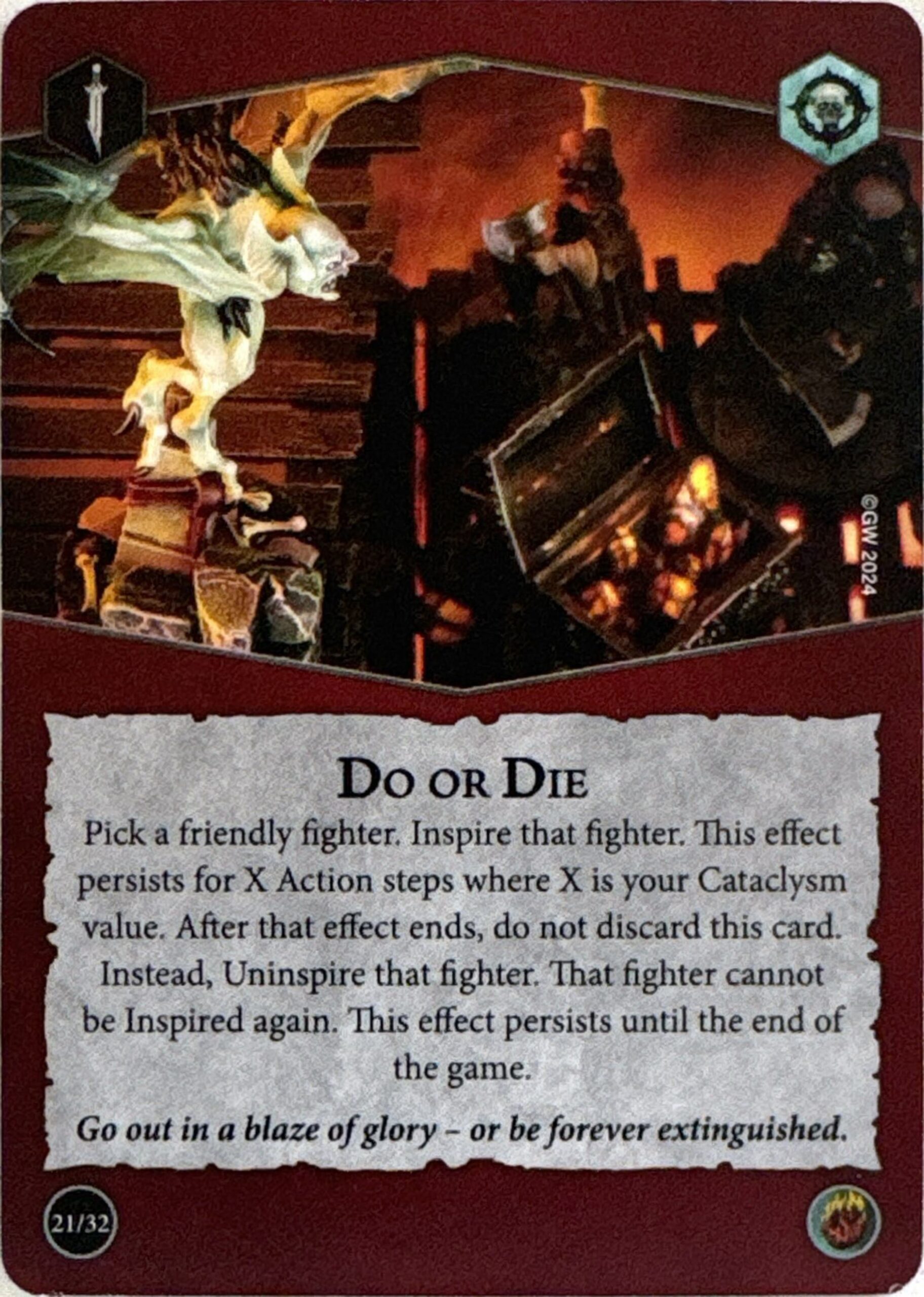
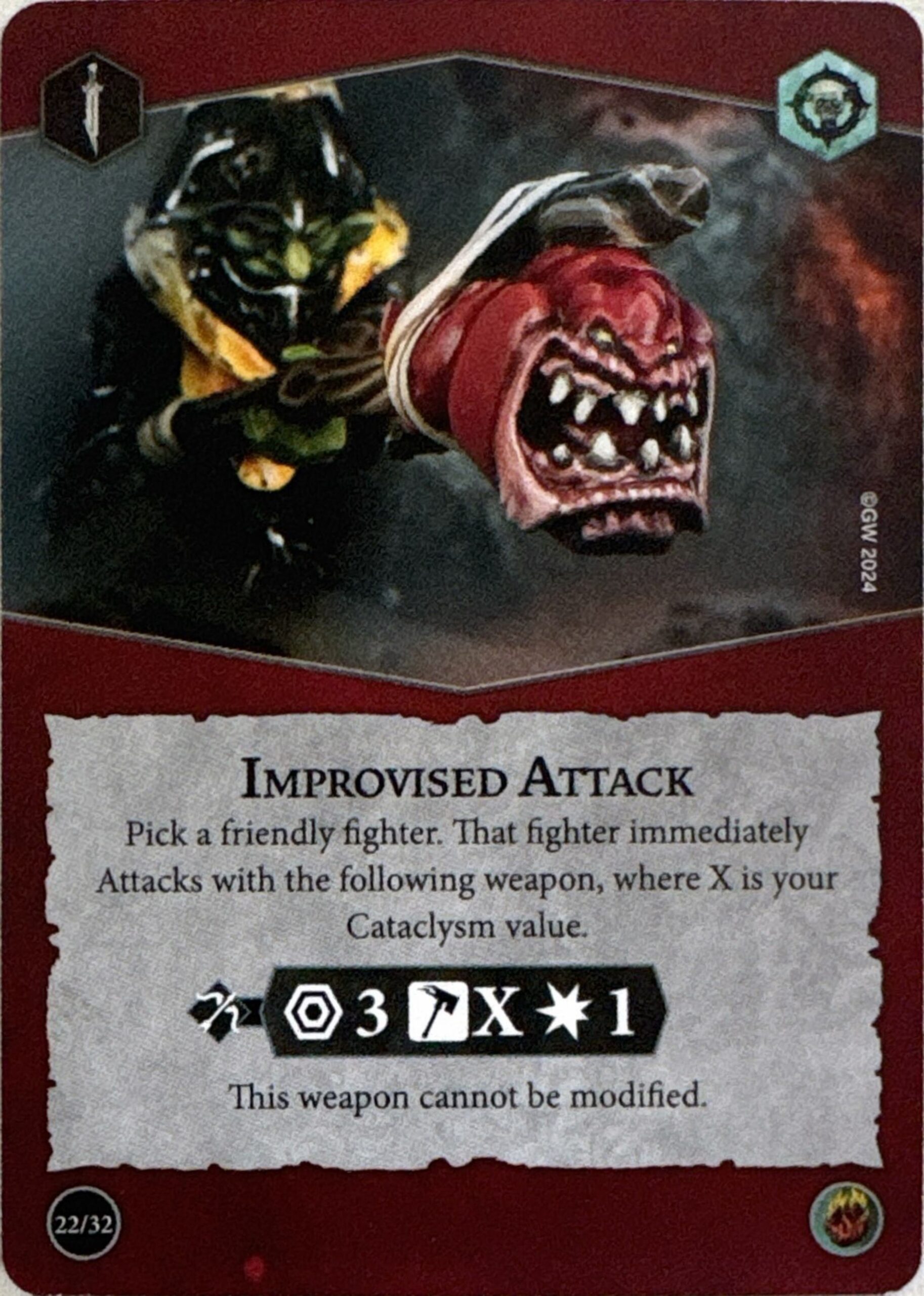
Do or Die
This is interesting card design but I think its value scales entirely with your warband and how hard their inspire condition is natively, as well as exactly how much payoff they receive for being inspired. Being permanently uninspired could be a hefty cost for some fighters or fairly irrelevant for others, although that then begs the question of why you wanted to use the gambit to inspire a fighter in the first place if you don’t mind them being uninspired. I ultimately think that for warbands with squishy fighters that don’t mind just having a one-time access on their big hitter, this could be very useful. In general, you’ll be inspiring a fighter and then charging with them rather than trying to activate the same fighter 2, 3, or even 4 times in a row to leverage their temporary inspiration.
Power: 2
Consistency: 2
Universality: 1
Improvised Weapon
I like this card. While its odds of actually delivering damage are not exceptionally higher than the previous pings we’ve seen in this deck, the fact that it synergizes with everything else that cares about making attacks (even ranged ones) offers it a lot of potential. Perhaps in Nemesis, you might be deckbuilding for objectives that care about making attacks, or even just for warbands that can inspire or trigger other effects off of this. While the attack cannot be modified, there are still ways for you to get additional benefits from this, and at minimum when comparing this to a ping we have to factor in the possibility of a drive back or an overrun. Since this is an acceptable attack at Cataclysm value 2 or higher, I think its playable.
Power: 2
Consistency: 2
Universality: 3
Upgrades
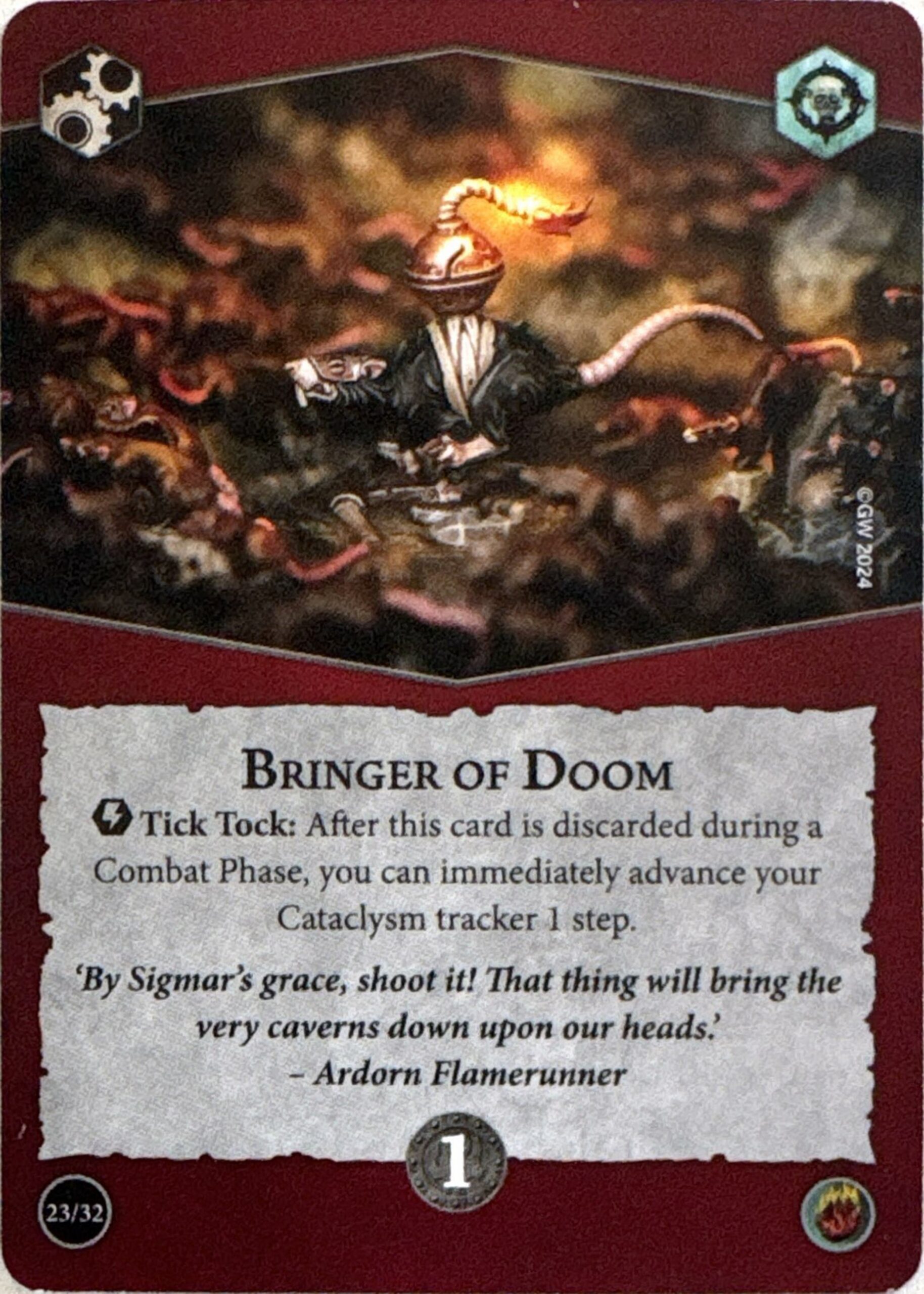
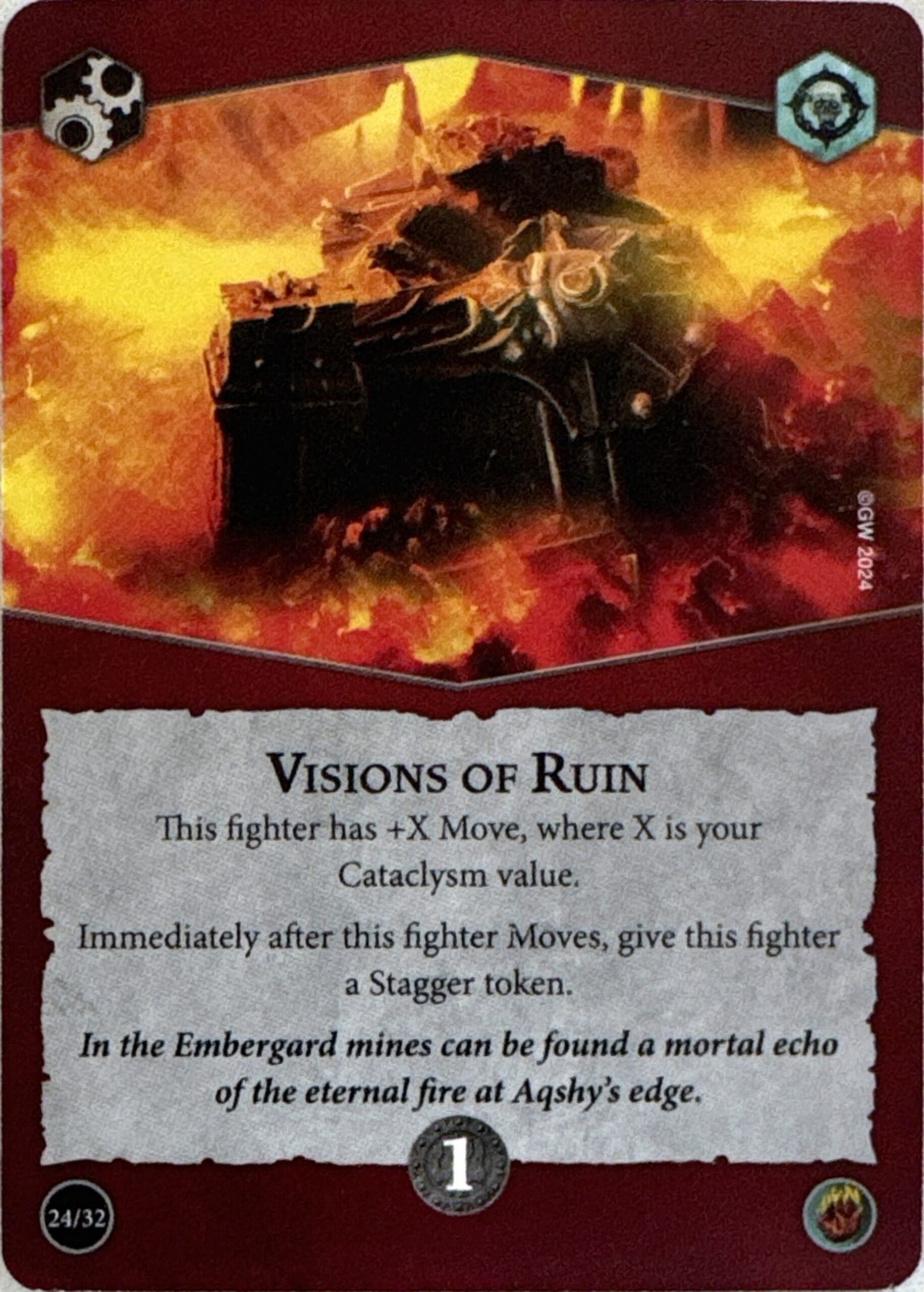
Bringer of Doom
This card is a bit meh, depending on FAQ. If you can use the surge ability printed on it when you discard it via focus action, it becomes substantially better, as an on-demand advance on the cataclysm tracker can score certain objectives or more importantly get you to the next breakpoint for a higher cataclysm value. Its a bit hard including a card only to discard it via an activation, however.
Power: 1
Consistency: 3
Universality: 2
Visions of Ruin
Increased move can be crucial for aggressive strategies or to reach a distant treasure token, and this card does scale up tremendously. There are even some synergies available in other decks once we get into deckbuilding to make up for the otherwise hefty drawback of staggering yourself. However, its also a bit under par by costing glory while many other movement upgrades are 0 glory. Time will tell if scaling up as high as +3 or 4 movement is enough to make up for these drawbacks.
Power: 2
Consistency: 2
Universality: 2

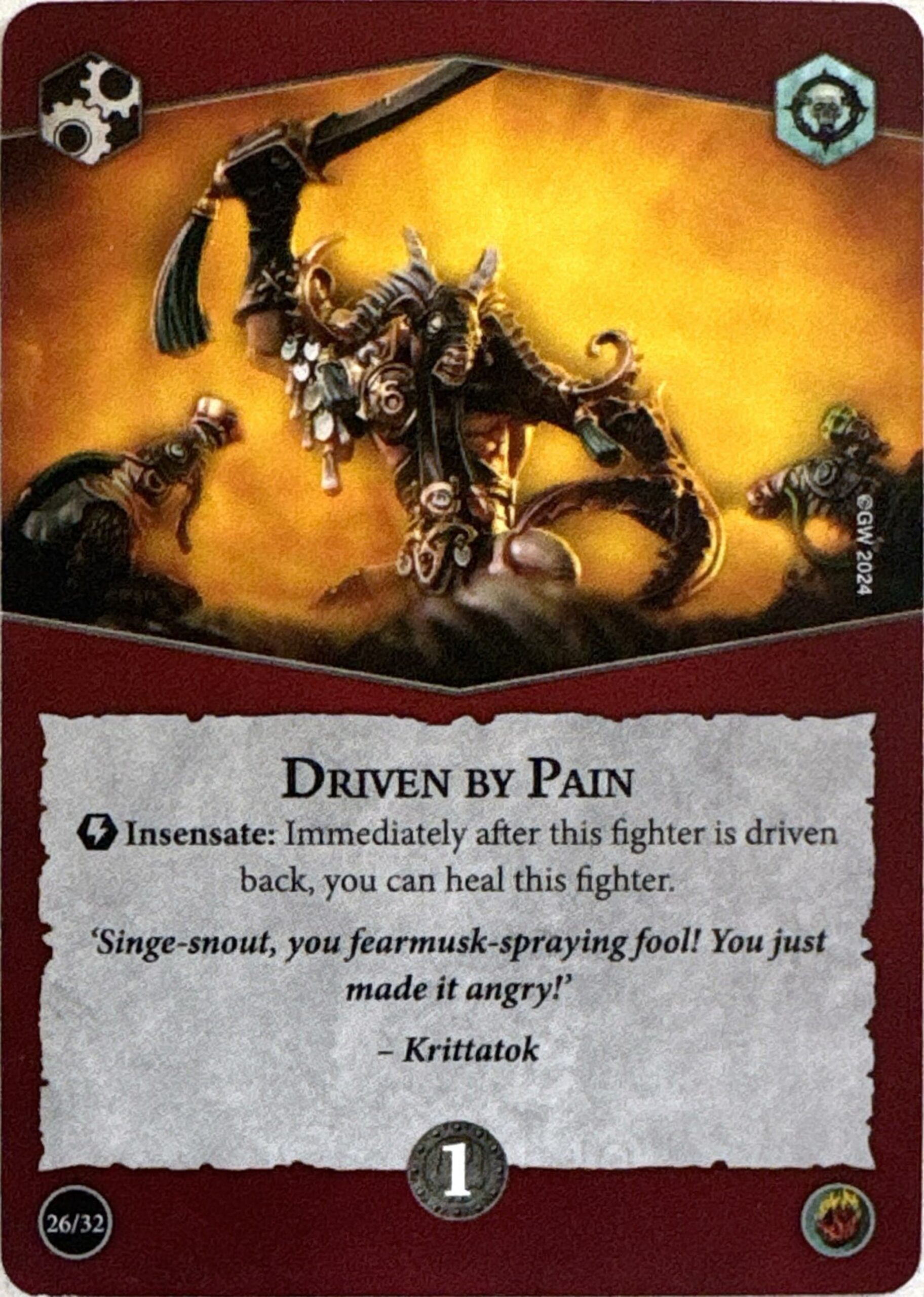
Extinction’s Edge
Another source of additional movement on the cataclysm tracker, this one is potentially repeatable but is unlikely to be so, and it is another upgrade that does nothing to help you actually get those kills.
Power: 1
Consistency: 2
Universality: 2
Driven by Pain
I think this is the sort of upgrade where the value isn’t actually apparent. As your opponent decides whether or not to drive you back, this card offers them a choice of displacing your fighter or dealing 1 less damage to you, assuming you survived the attack. Its not terrible, but like all such catch-22 cards it must be evaluated with the assumption that your opponent is competent and will drive you back when it would hurt you more than not being healed would.
Power: 2
Consistency: 1
Universality: 2
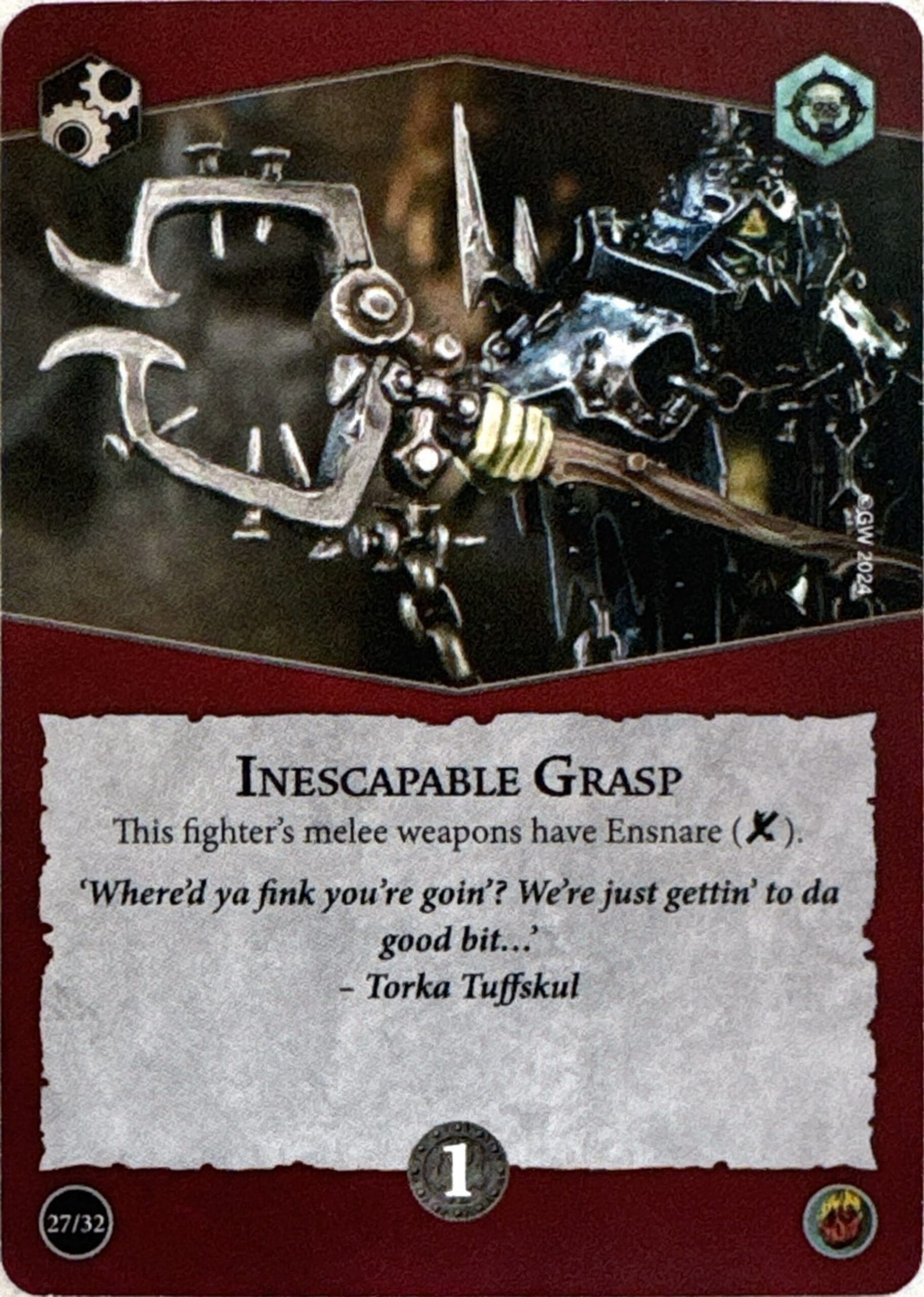
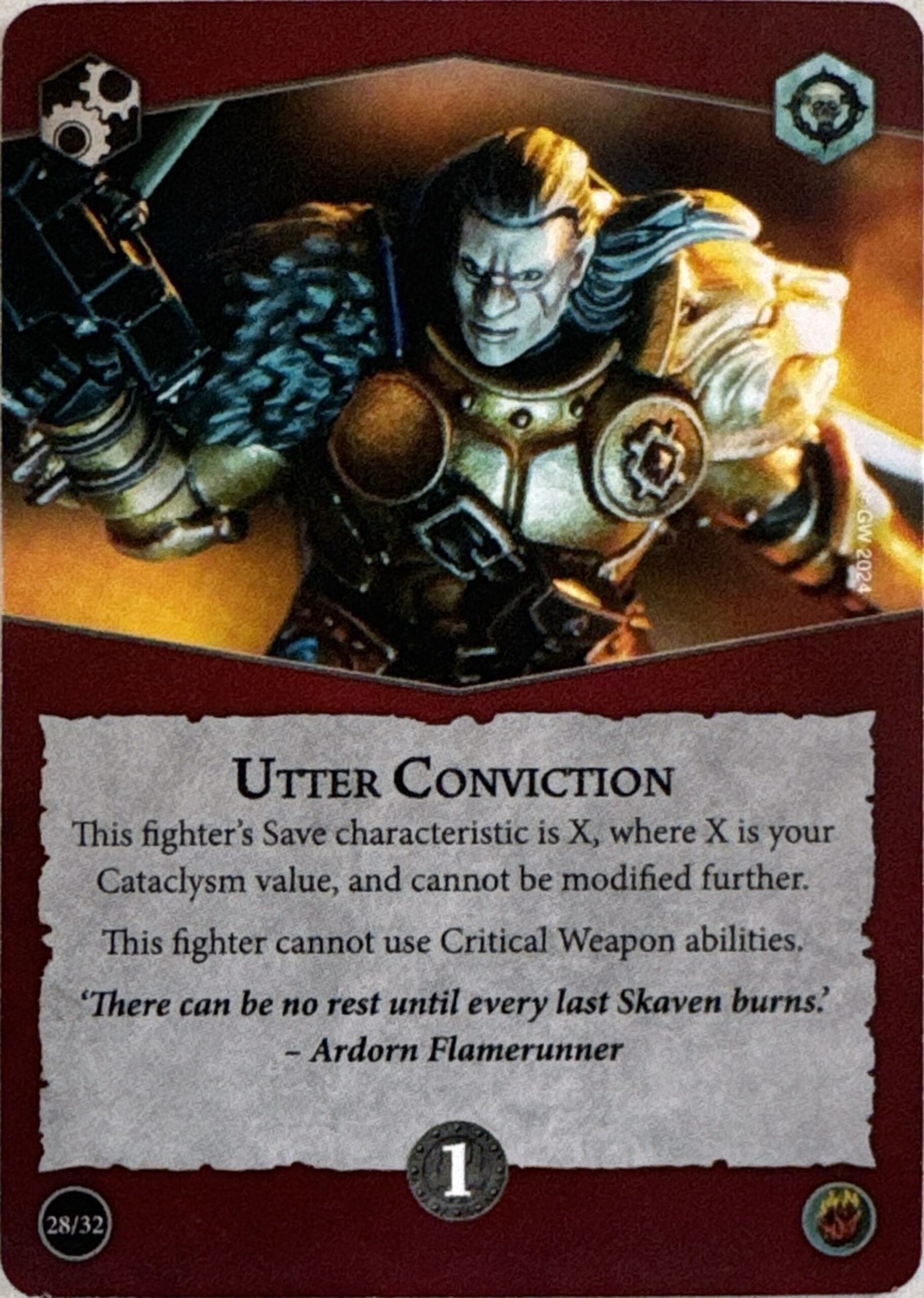
Inescapable Grasp
We’ve badmouthed upgrades that do nothing more than grant ensnare for a long time now and I don’t intend to discontinue that grand tradition just yet. While yes, attacks have become less accurate, the new rules also mean that gaining ensnare comes at the cost of cleave/grievous/etc. Marginal bonus points for at least helping with 1 of the surges in the deck, but this is also matchup-dependent and not necessarily the most exciting of upgrades.
Power: 1
Consistency: 2
Universality: 2
Utter Conviction
Talk about a massive cataclysm value payoff. For elites and hordes alike this can make your last man standing nigh untouchable in the late game, with a drawback that may be negligible. Even early, it is reasonable to reach Cataclysm value 2 quickly, so with the exception of Round 1, this card is boosting any 1-save fighter up to 2 and it only gets better from there.
Power: 3
Consistency: 2
Universality: 2

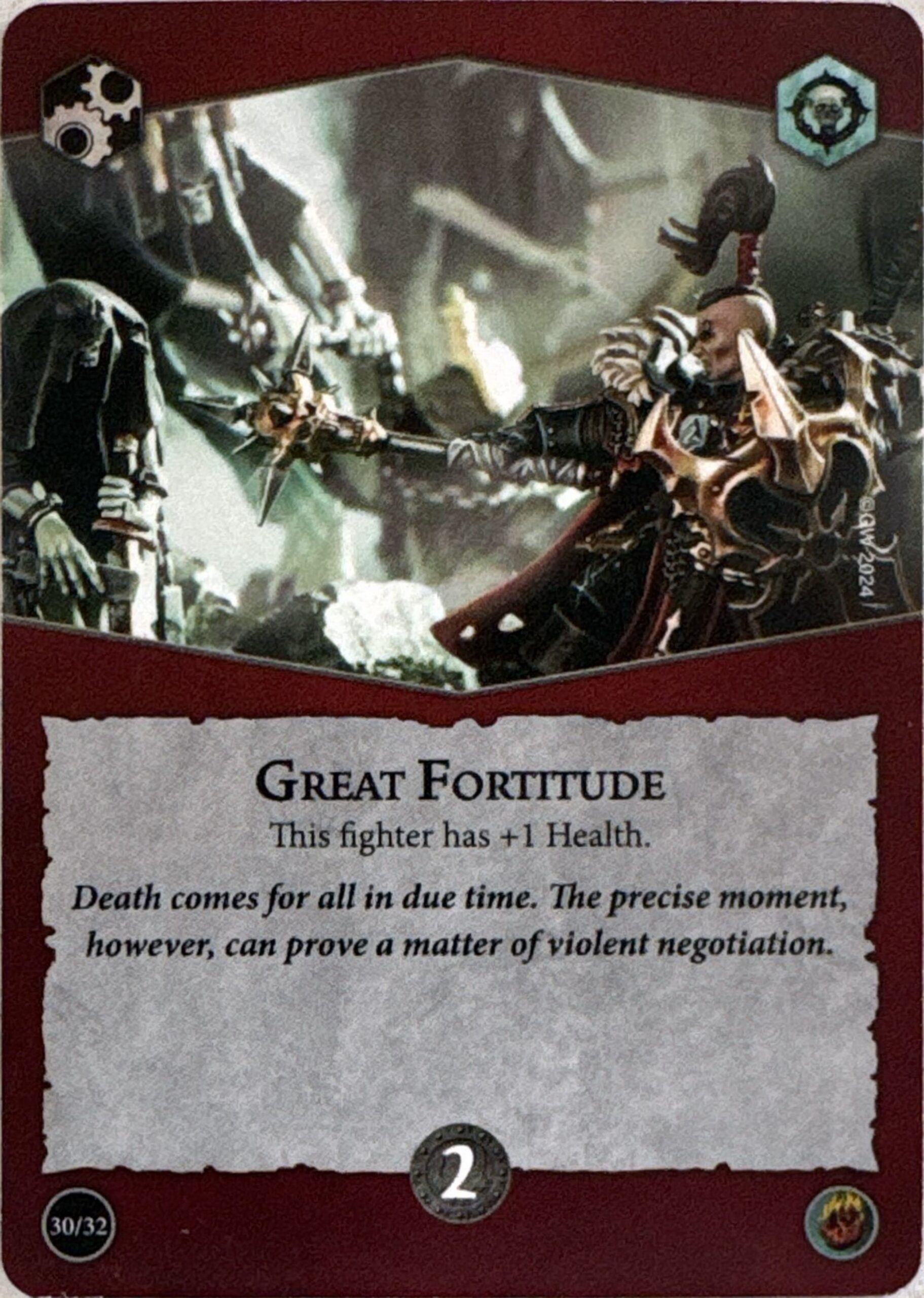
Burnt Out
While drawing cards is always good, spending a card and an action to draw them when I could’ve simply used the Focus ability seems like a hard sell – in a vacuum, again, I could discard this card when focusing and draw the same amount of power cards and have the option to cycle through my objectives too, without ever needing to take up some of my glory limit for upgrades. The underdog bonus is nice, but in a situation where I’m happily spending an activation to draw cards I am sure I could find 2 cards I don’t need and am willing to throw away in order to draw 3.
Power: 1
Consistency: 3
Universality: 2
Great Fortitude
Now that fighters have their own bounty characteristic, gaining additional Health is all upside once again, and not even the extra glory cost for this upgrade is enough to keep it down. There’s not much to say other than that this was, is, and will be a staple.
Power: 3
Consistency: 3
Universality: 3
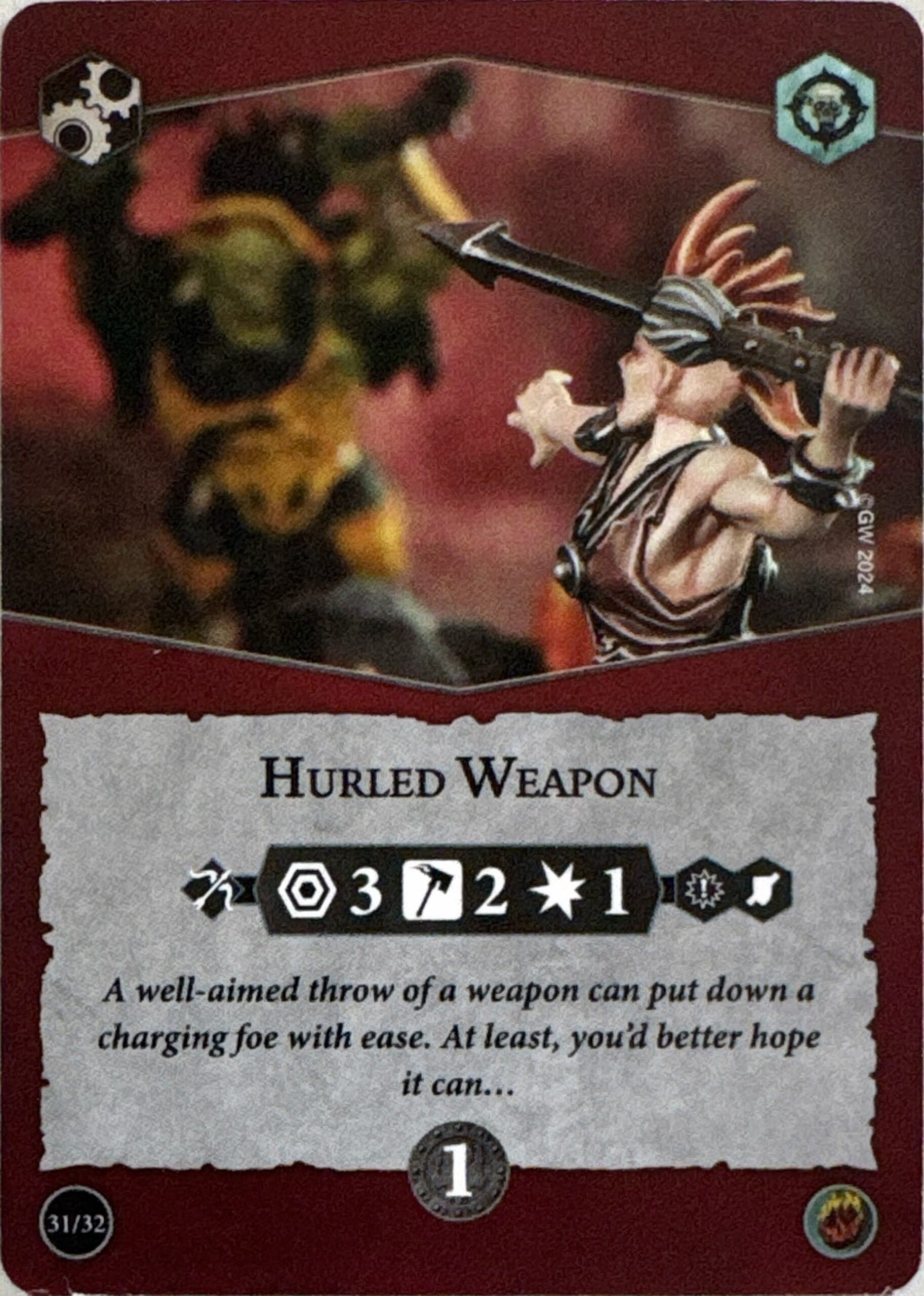
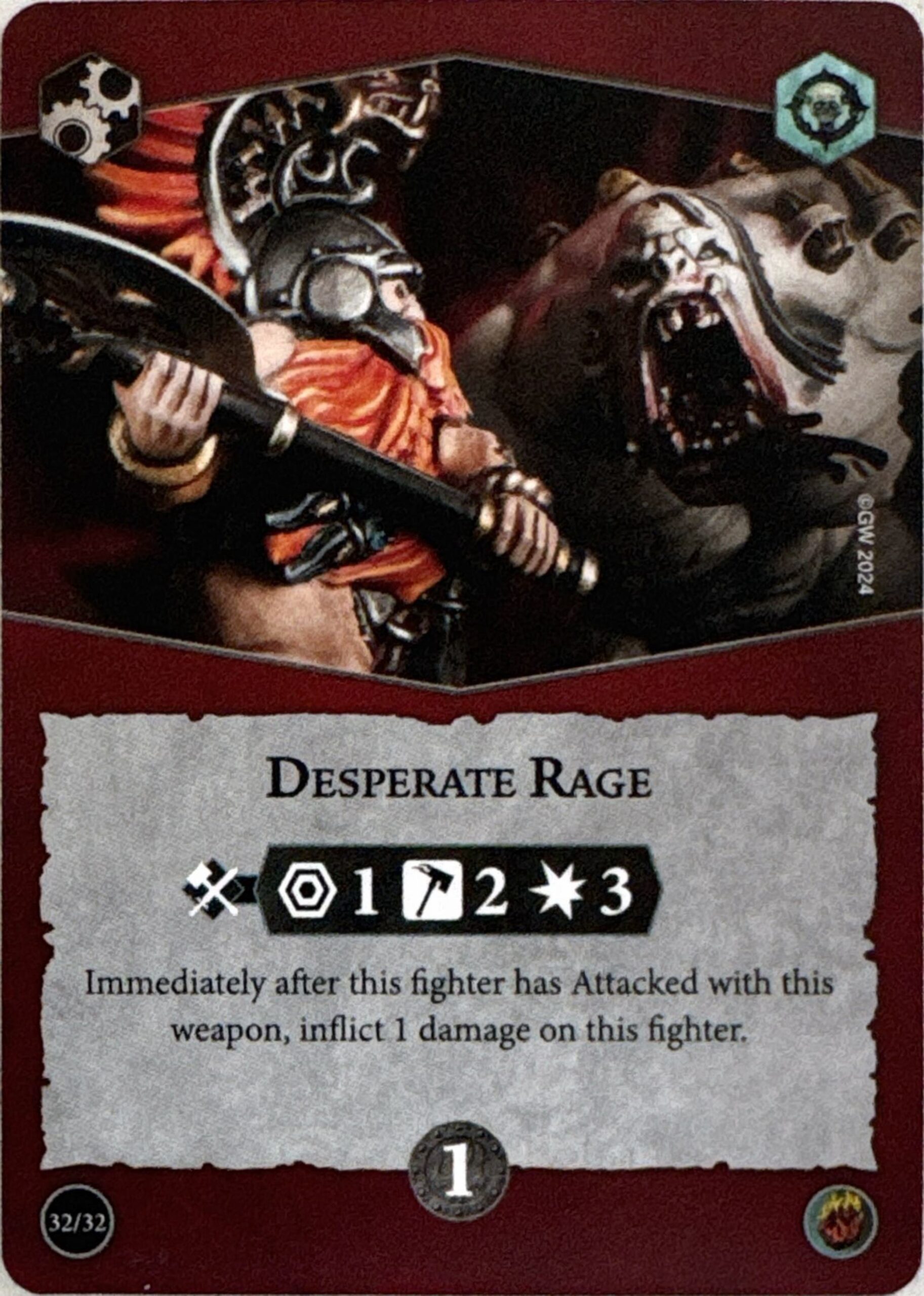
Hurled Weapon
Weapon upgrades are always useful, but generally their relevance is strictly based upon the warbands using them. From what we’ve seen of current fighter profiles, this attack action is a fairly standard, yet mediocre bar for ranged attacks, so for warbands lacking range this could be a great boon and for those who already possess it, this will be a redundant card that is easily skipped.
Power: 2
Consistency: 2
Universality: 2
Desperate Rage
As I said above, weapon upgrades are always useful. In this case, however, we see a much stronger potential upgrade, as this attack profile seems a cut above the average in terms of damage, and for the horde warbands synergizing with the previous cards that are willing to sacrifice their own fighters, the drawback is a moot point. Additionally, the deck lacks any upgrade for +damage, but this card is functionally an option for +damage for any fighter who didn’t already do 3 damage base on their attack actions.
Power: 3
Consistency: 2
Universality: 2
Conclusion
All in all, the deck is a bit of a mixed bag in terms of what it demands from players. There are some aggro elements in the objectives, some hold elements, and the plot card and weapon upgrades in the deck push it more for horde warbands. All in all, it is certainly an interesting deck design with some iconic older cards returning in tweaked forms.
Returning to the plot card, I think its important to recognize exactly how quickly (or slowly!) we might be moving along that cataclysm tracker. Starting the game at Cataclysm value of 1 on the first step of the tracker, and while we can generally safely assume we will actually lose 1 fighter each round to get one step, the other factor is substantially more open to enemy counterplay. If the enemy is going to be holding tokens, you may not actually reach cataclysm value 3 until after the 3rd battle round, significantly limiting the payoff for a number of the power cards in the deck. On the other hand, if the enemy is being aggressive, or if you are able to deny tokens to them, you will rapidly accumulate cataclysm value. More experience and time will tell before we fully understand the flow of this mechanic, I feel.
In any case, the deck does offer some interesting lines of play and synergizes with multiple playstyles, so I look forward to mixing this deck with a number of Nemesis brews. Until then, we wish you the best of luck on YOUR Path to Glory!



